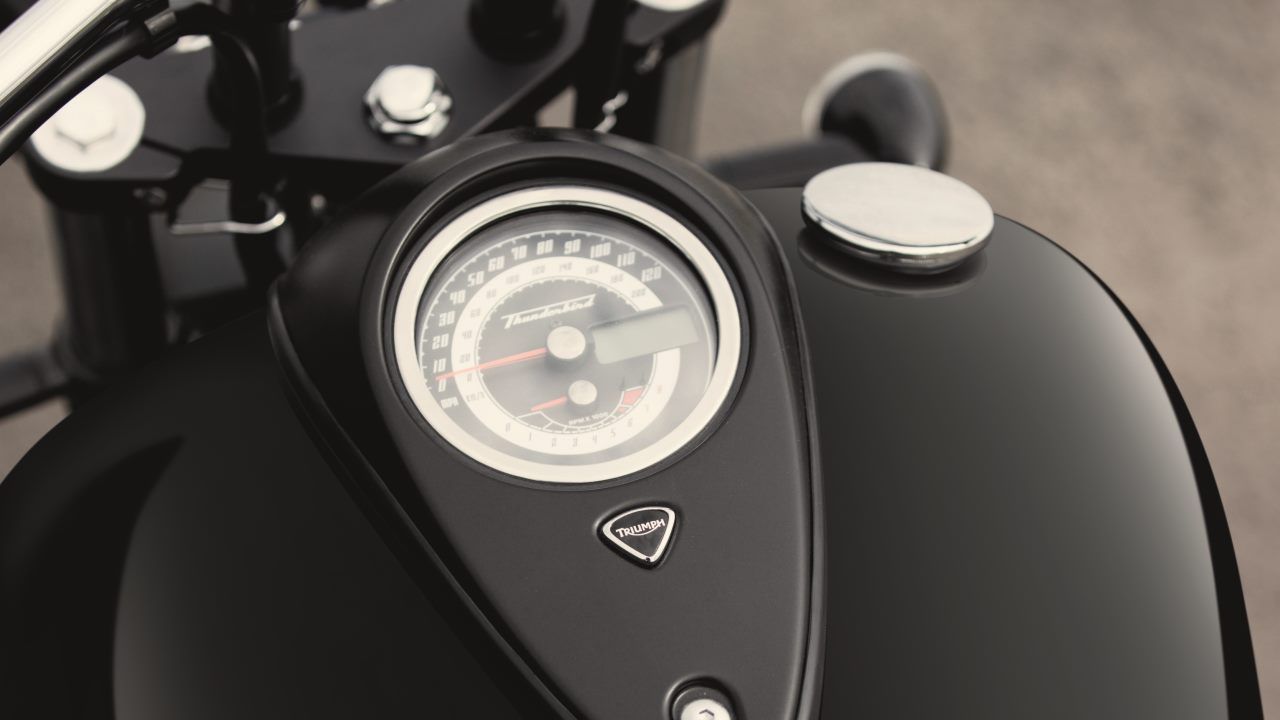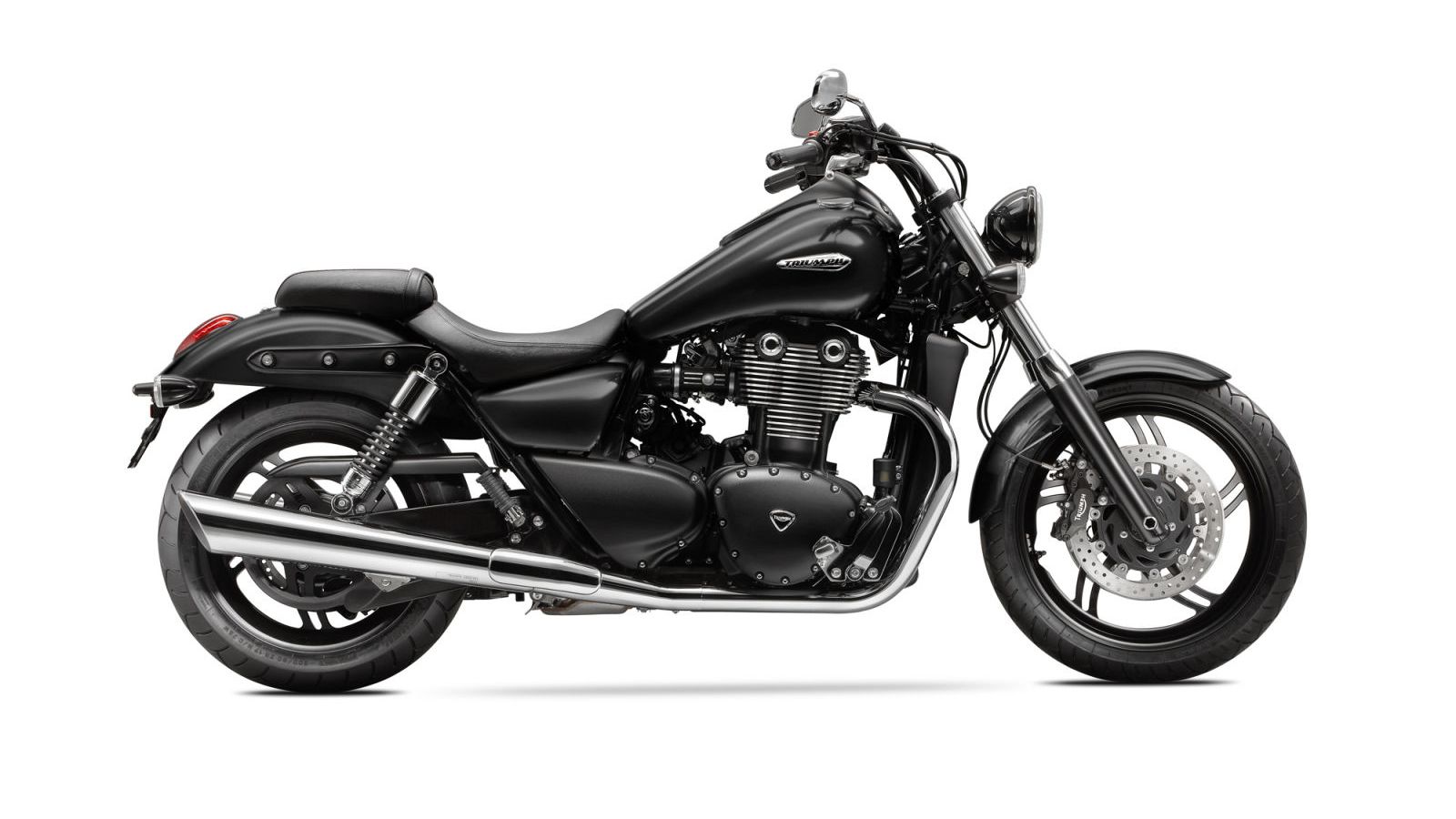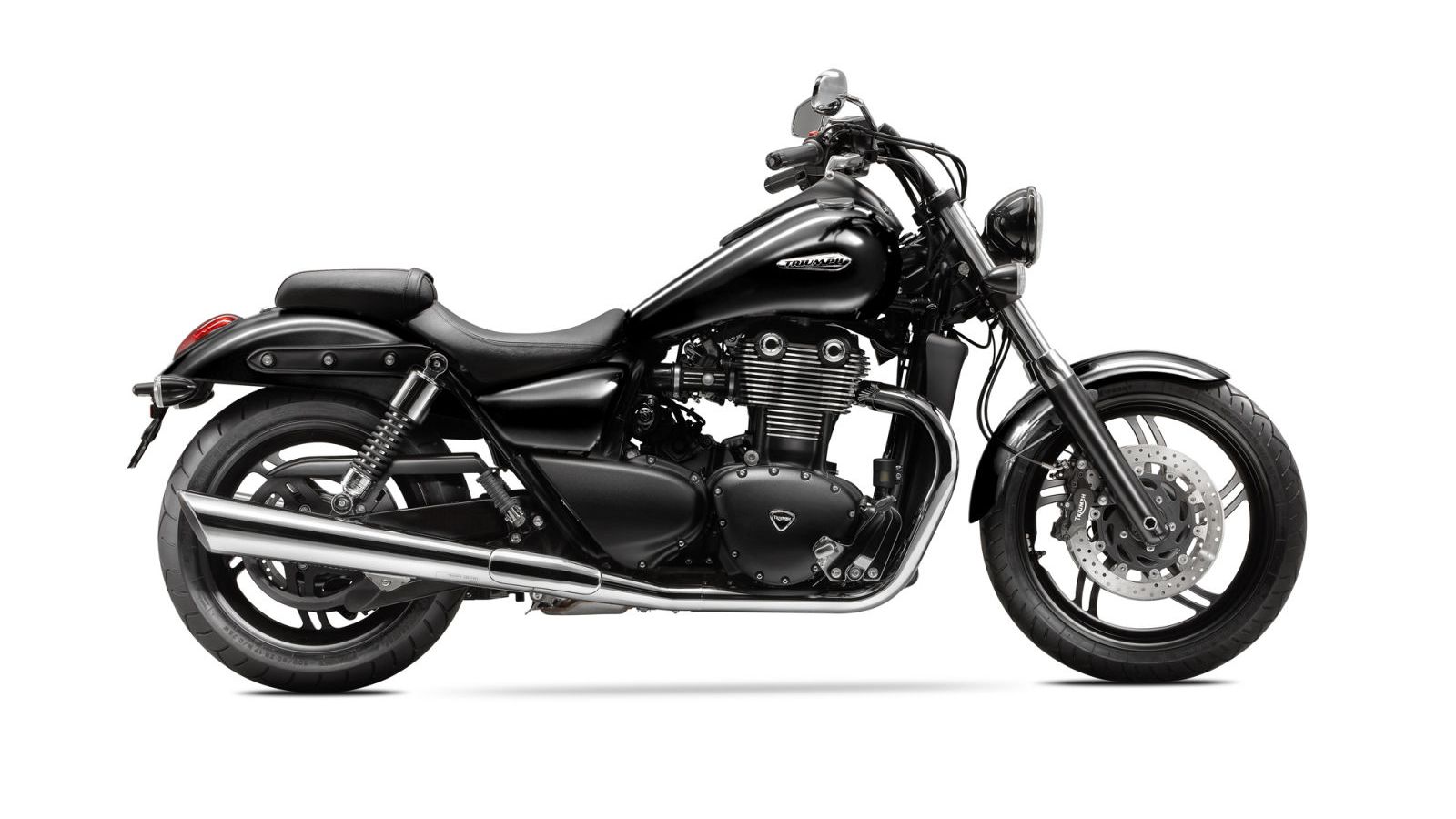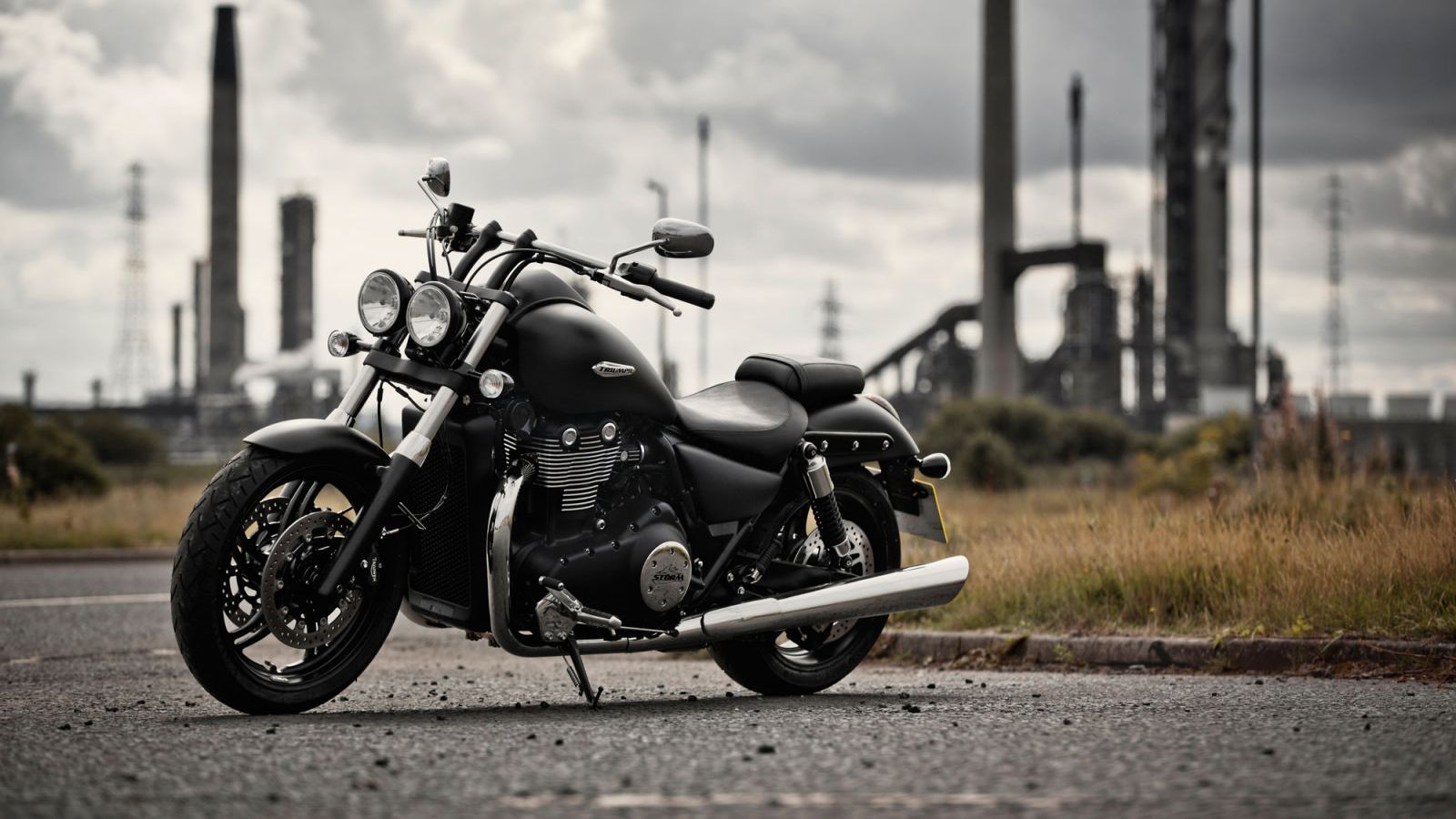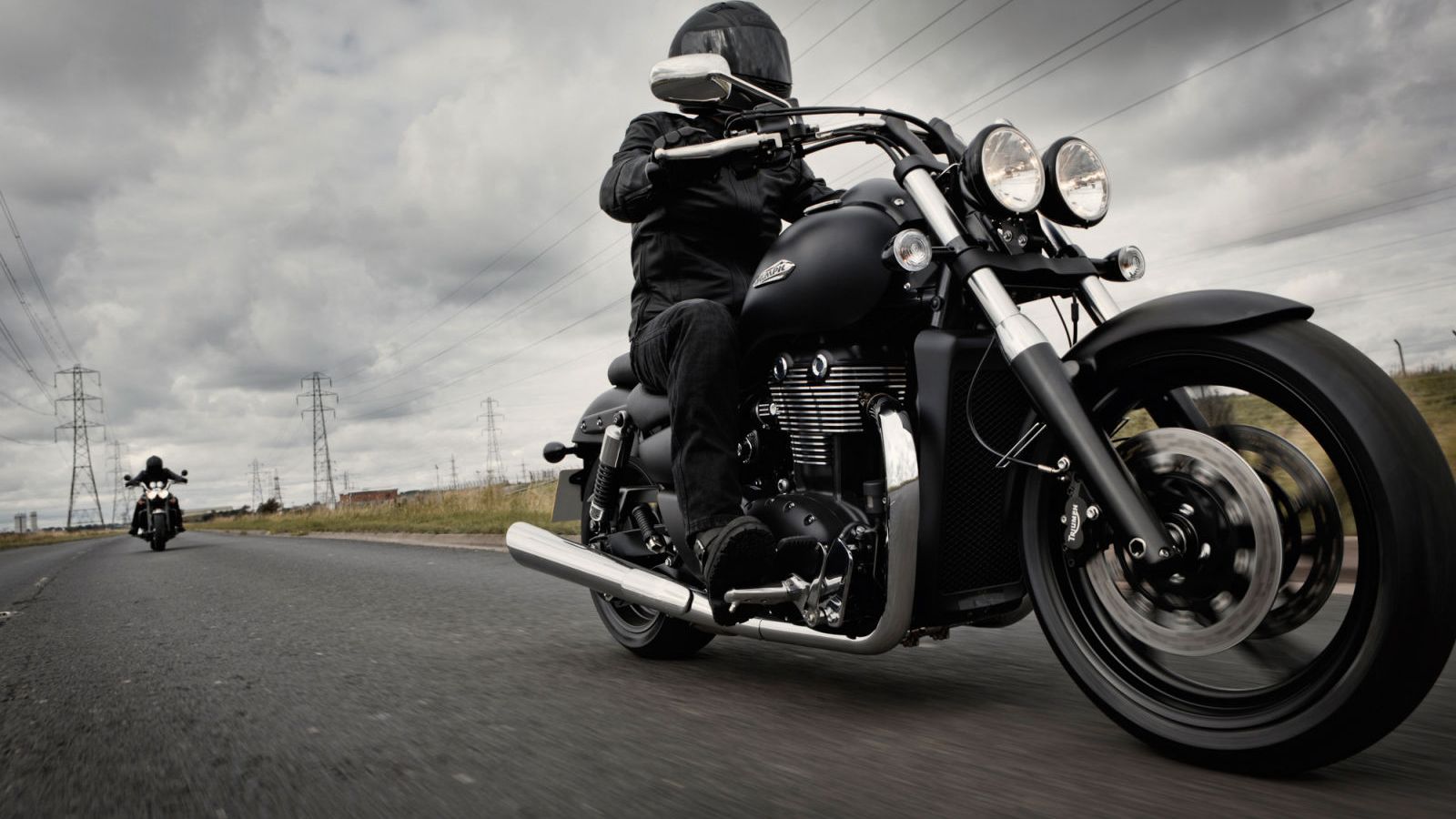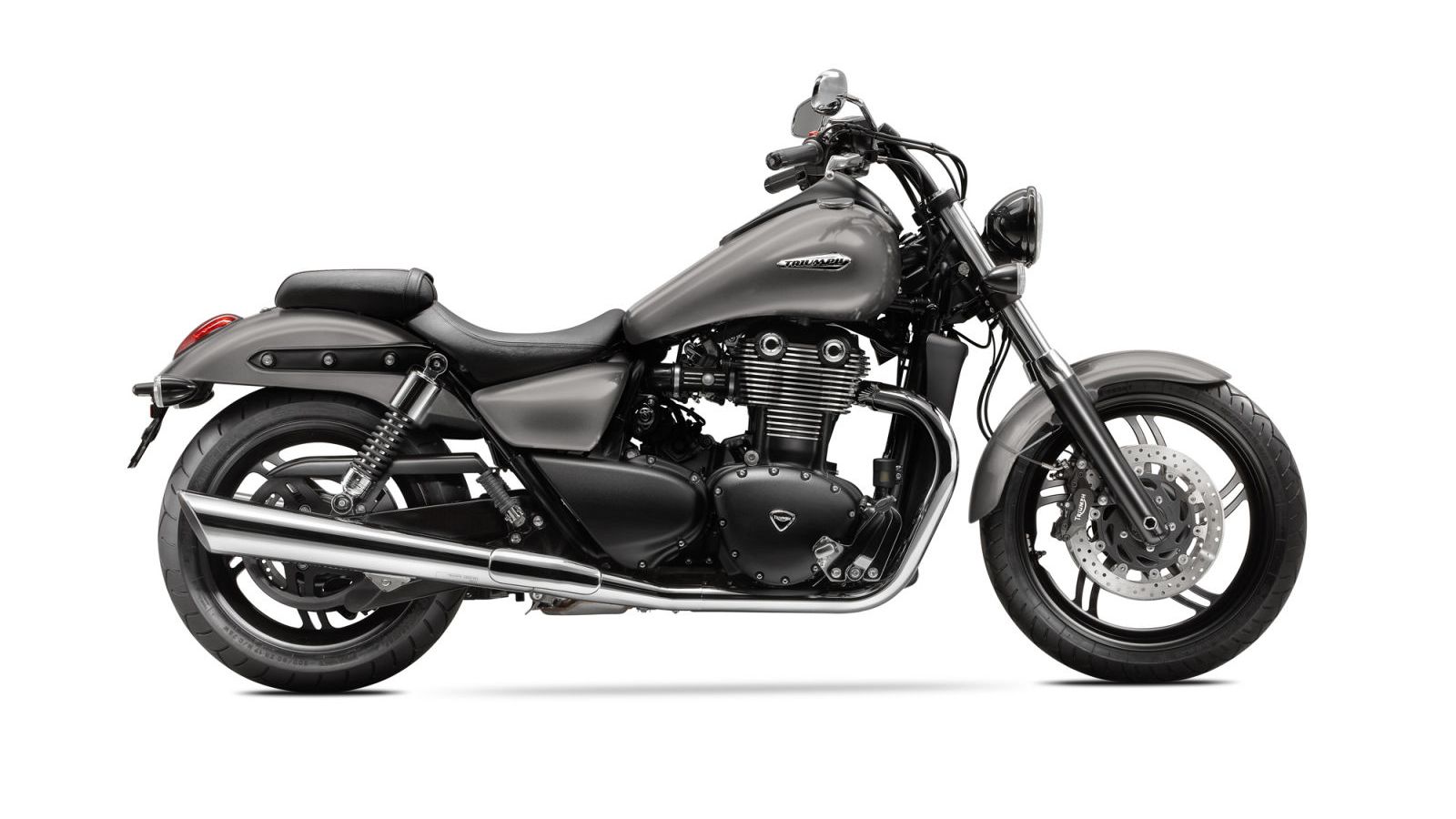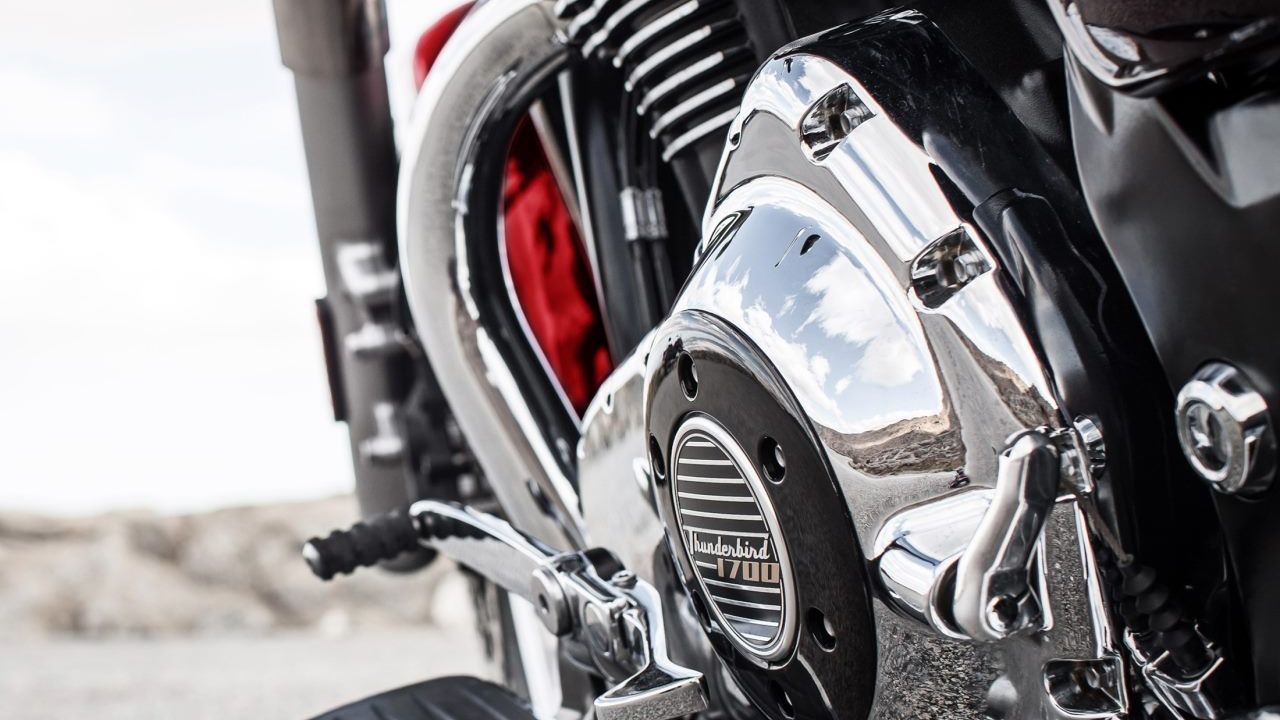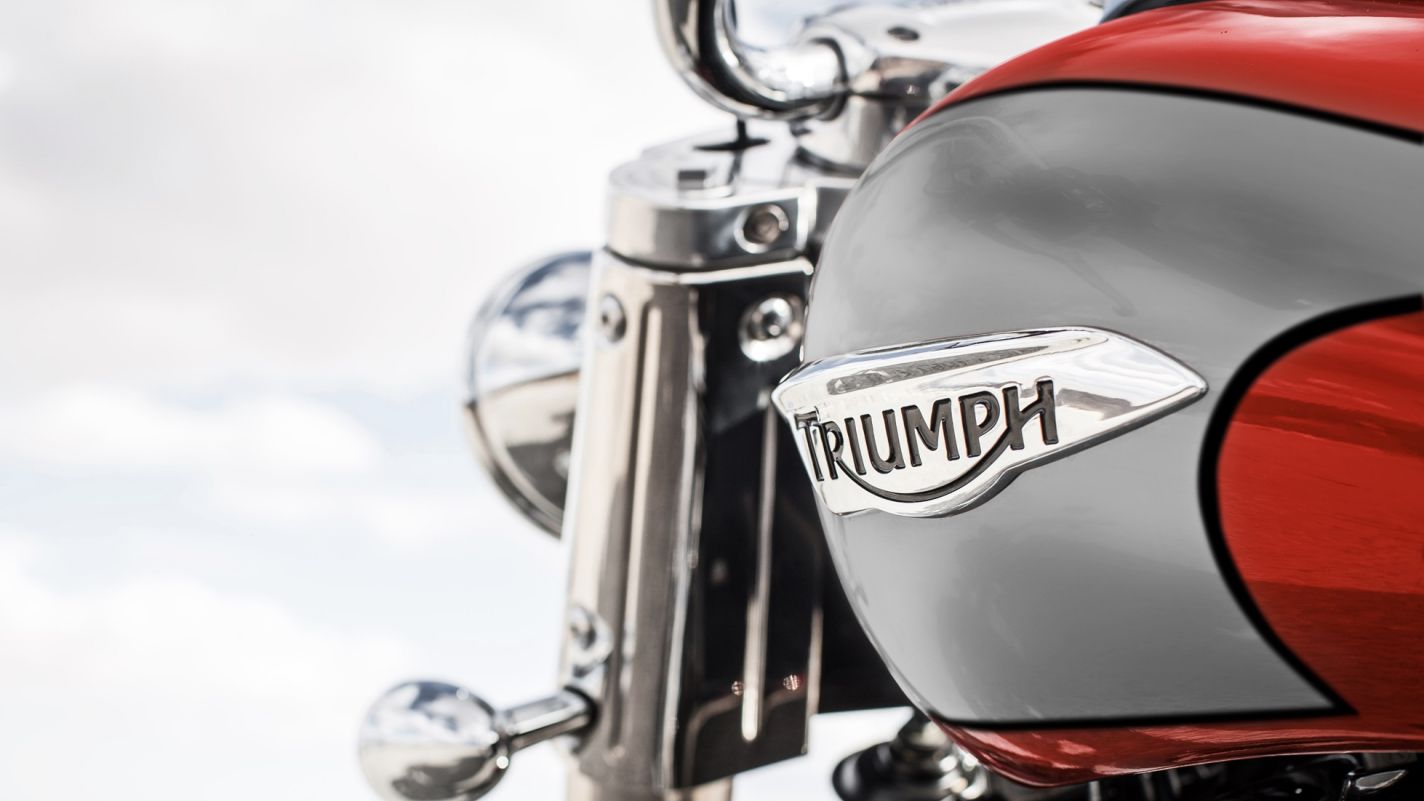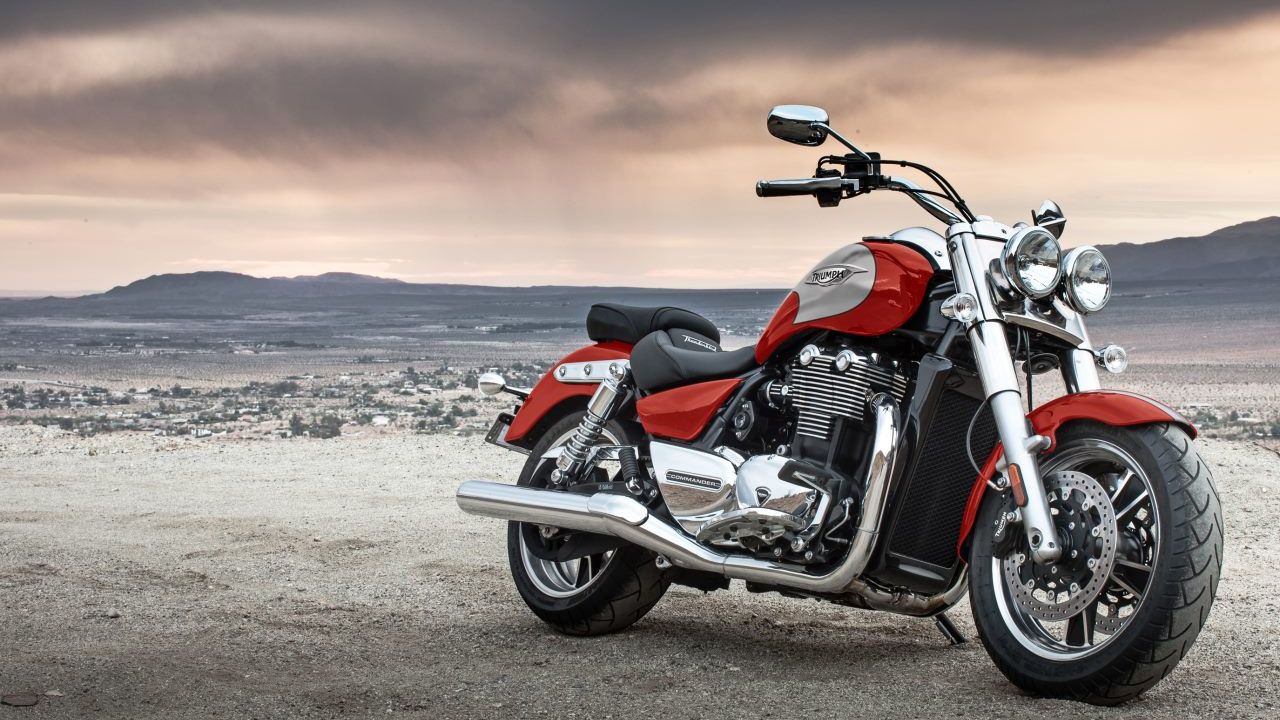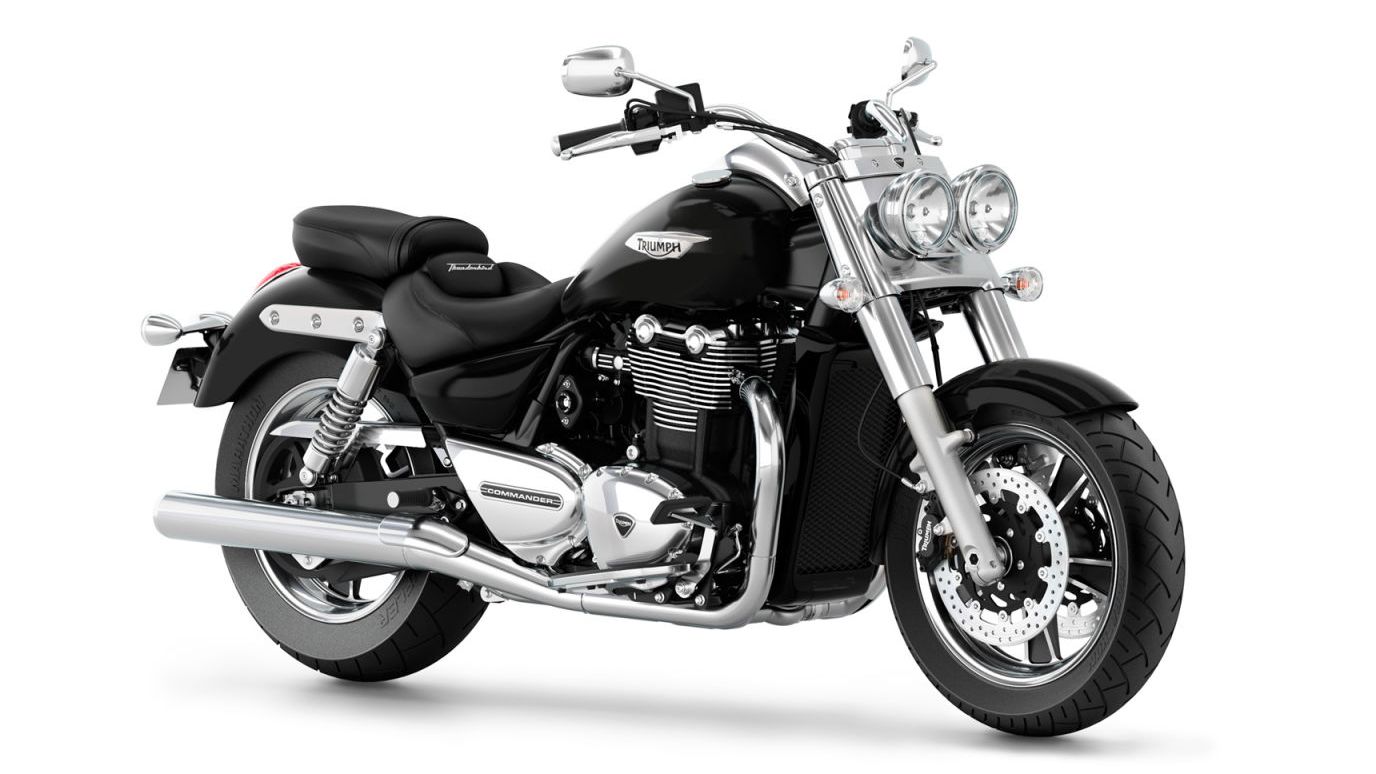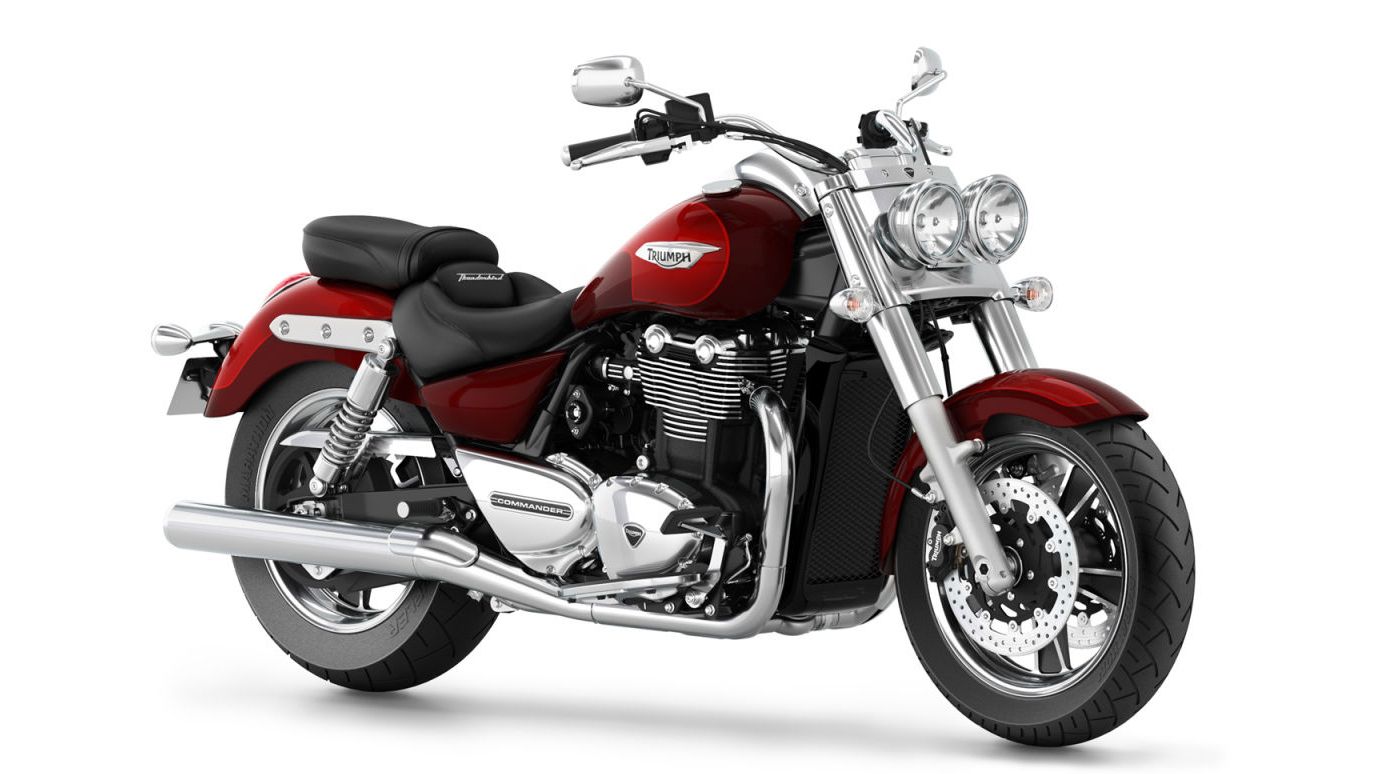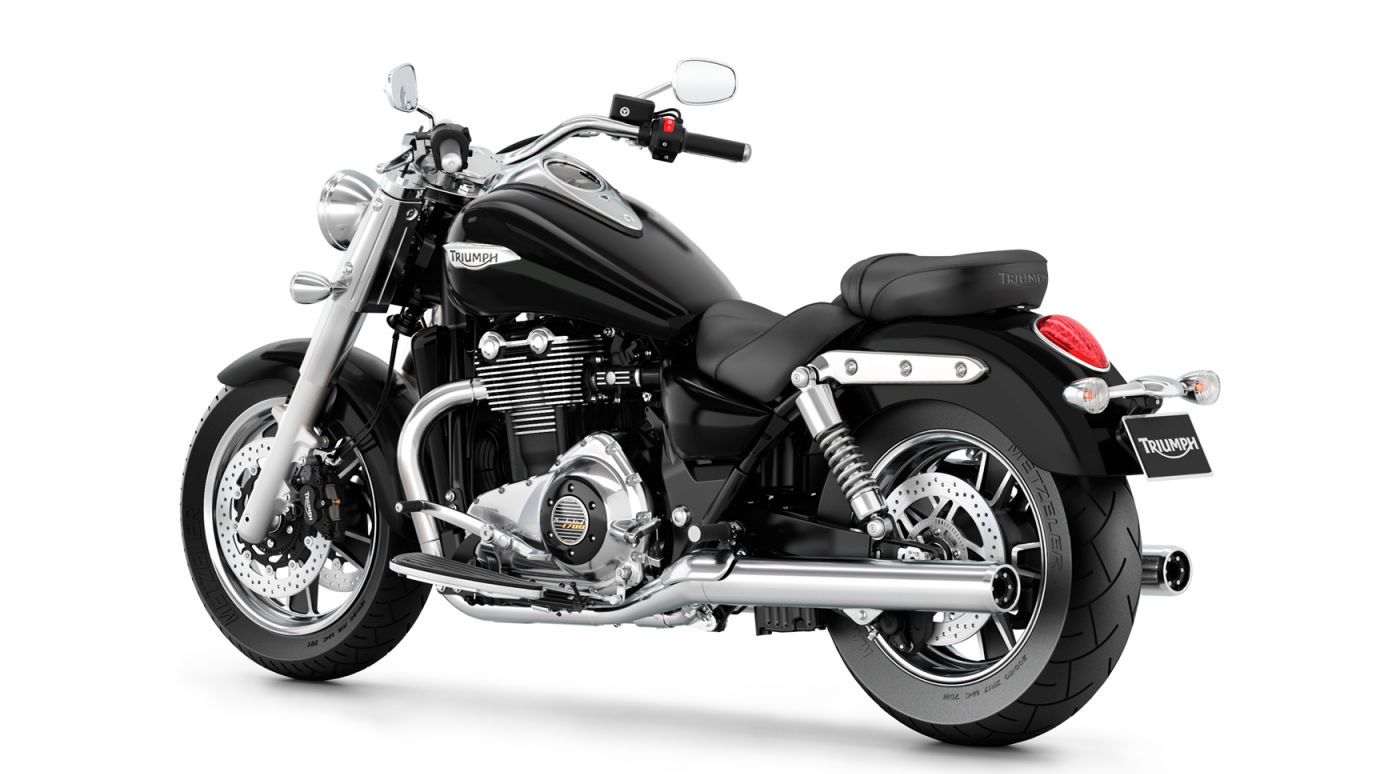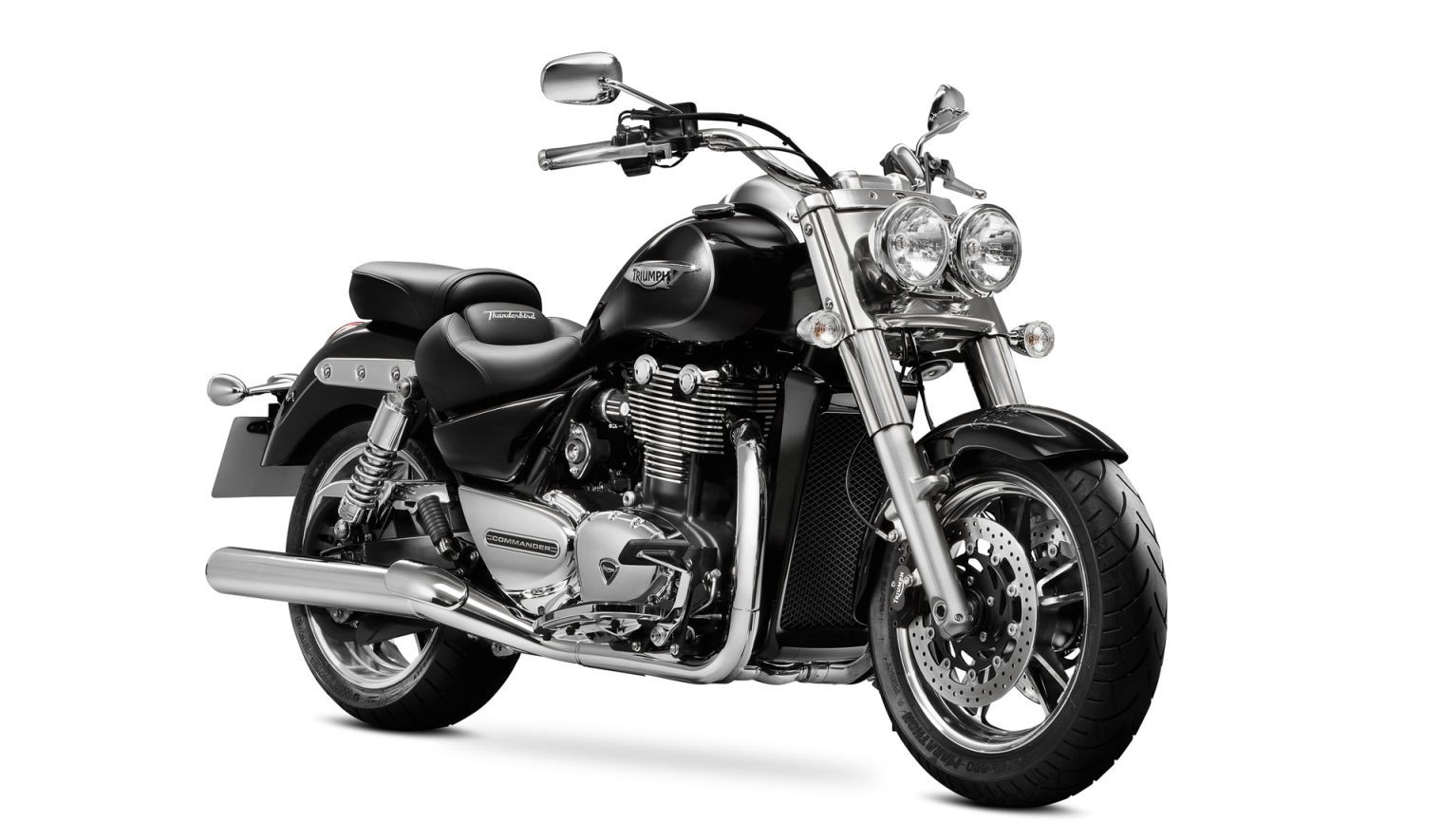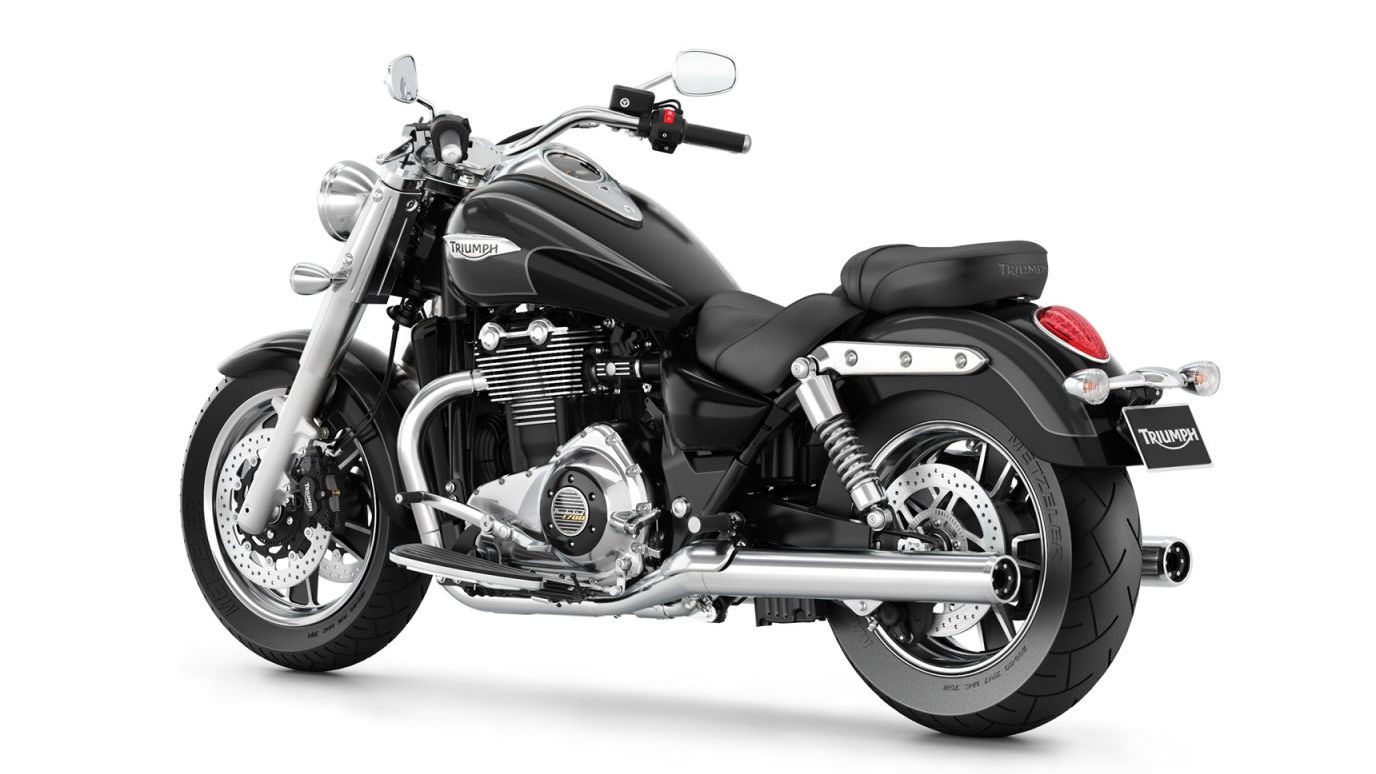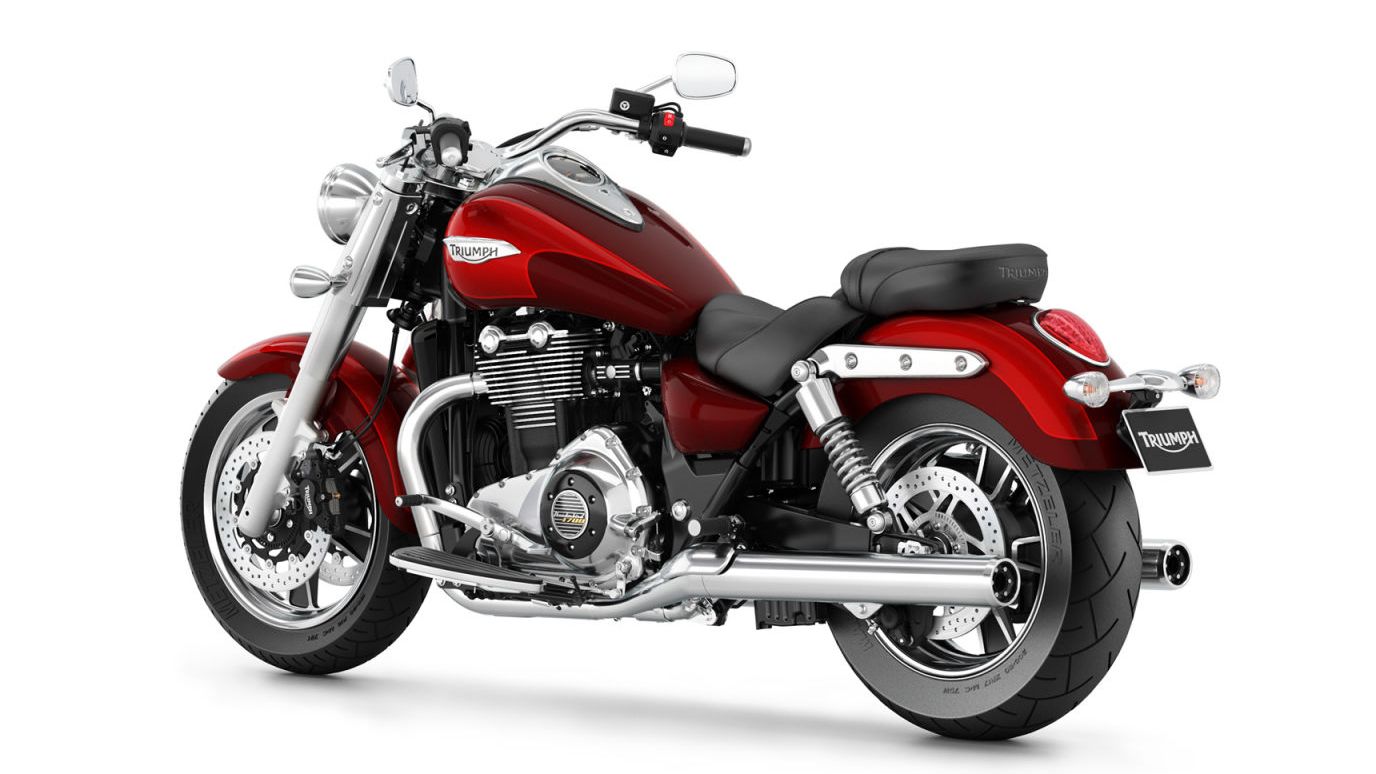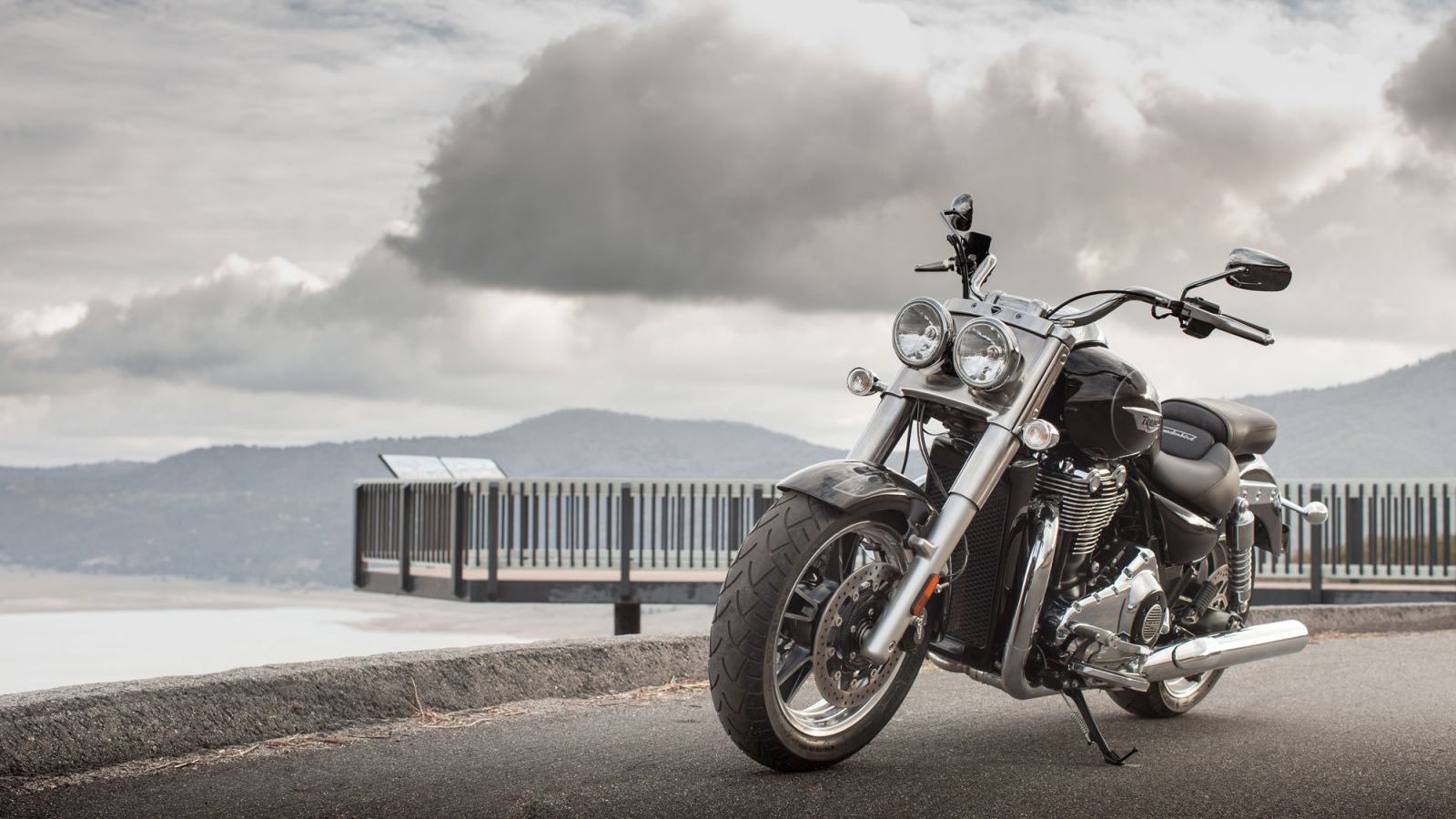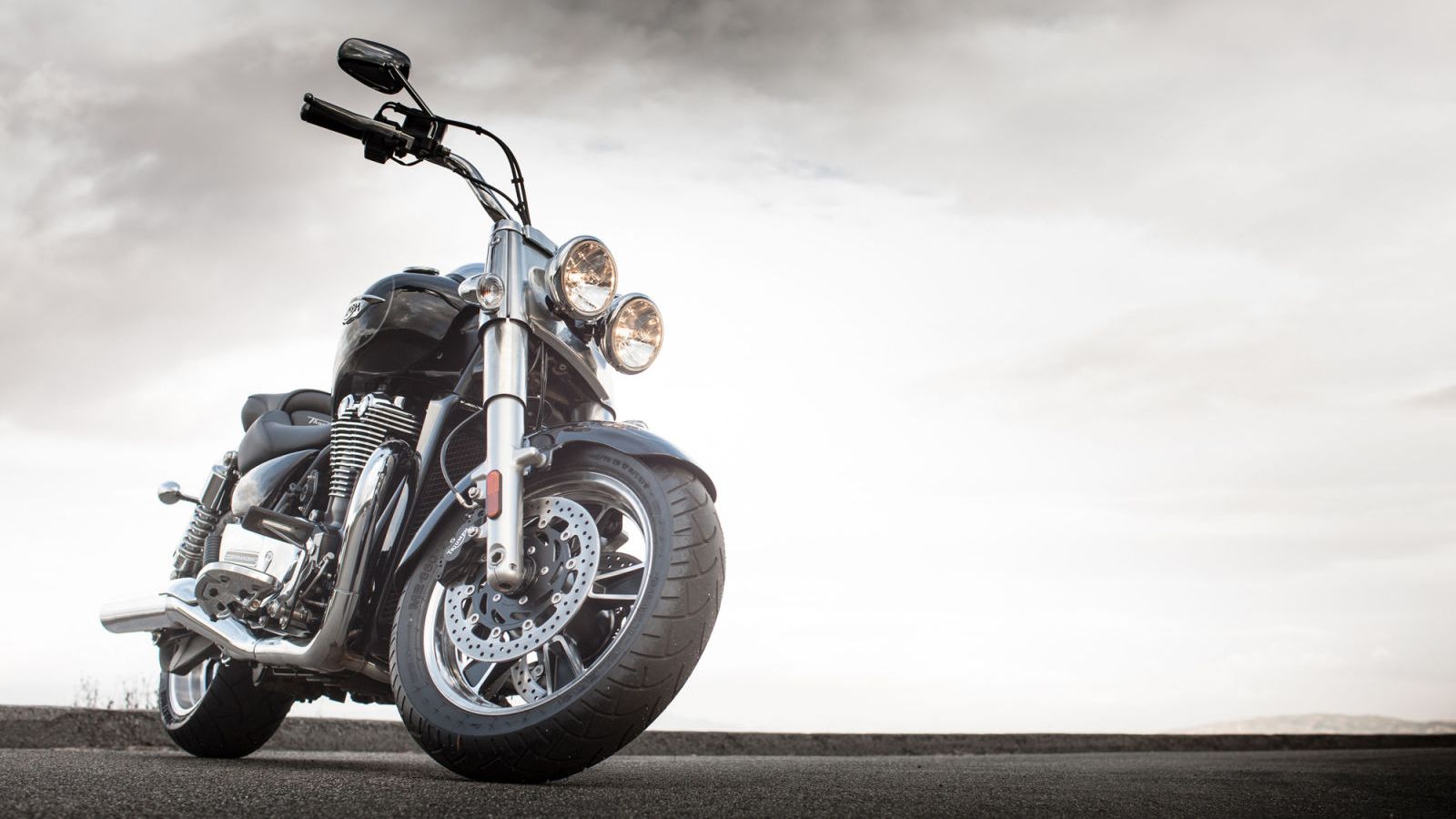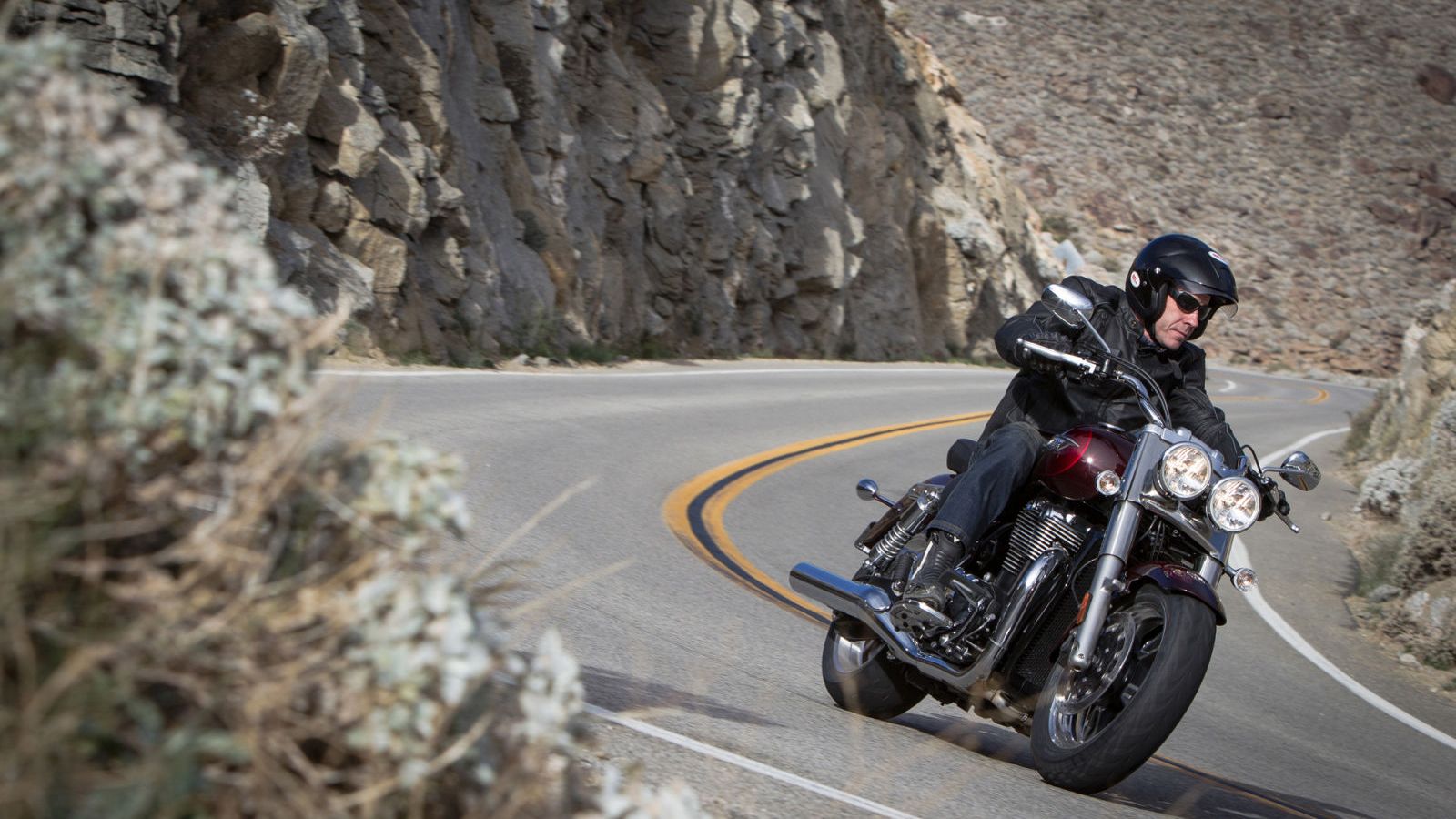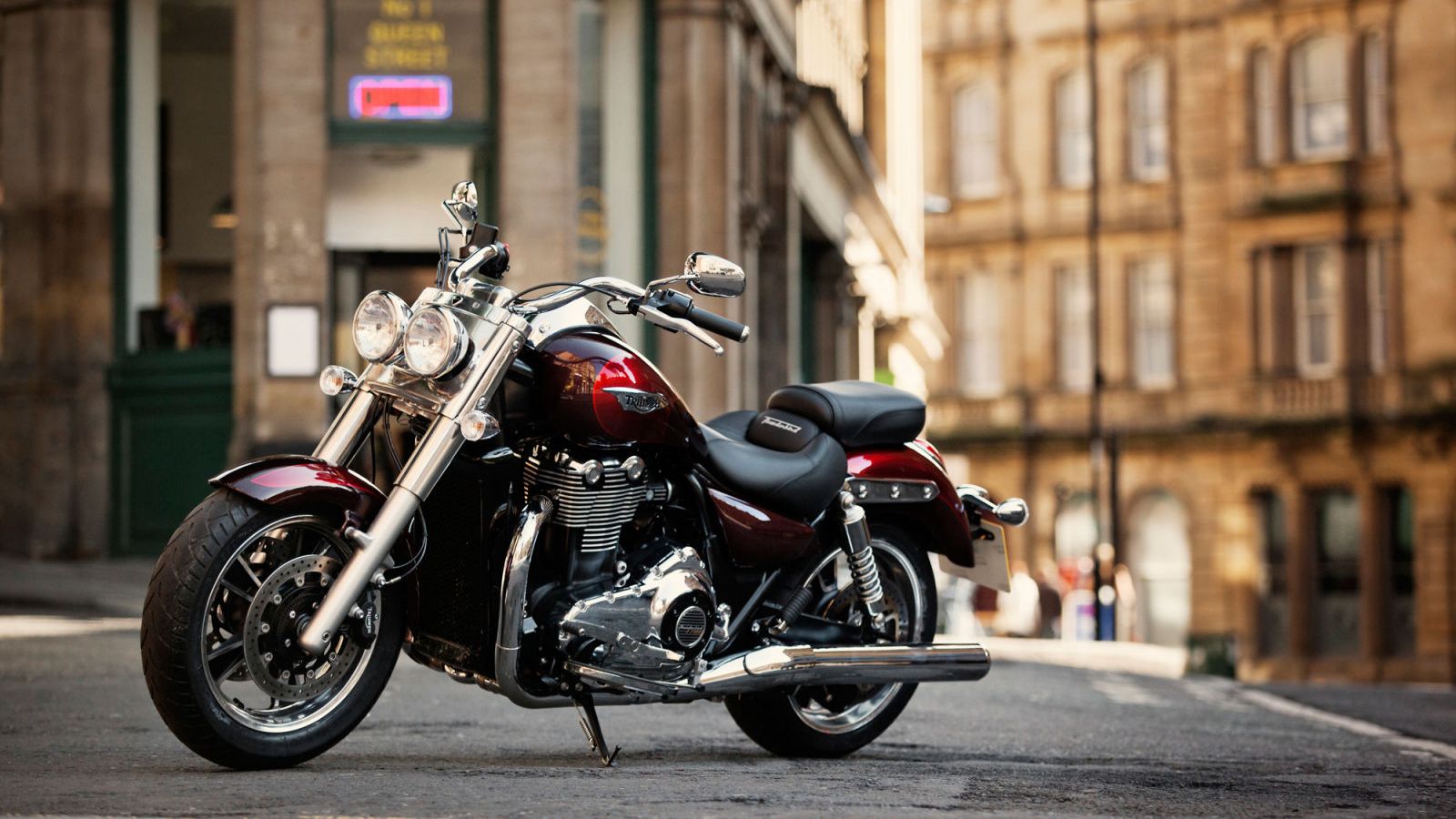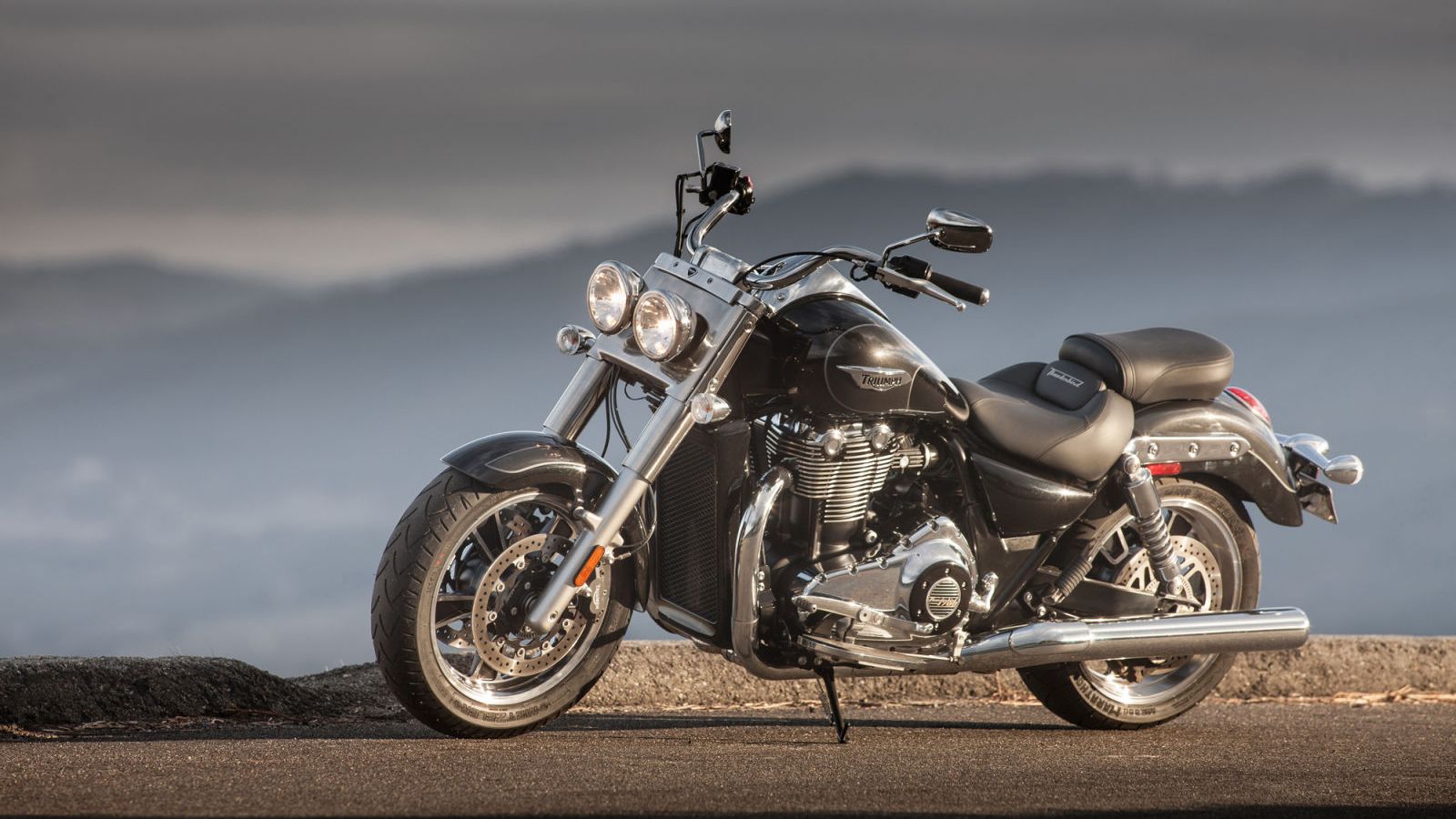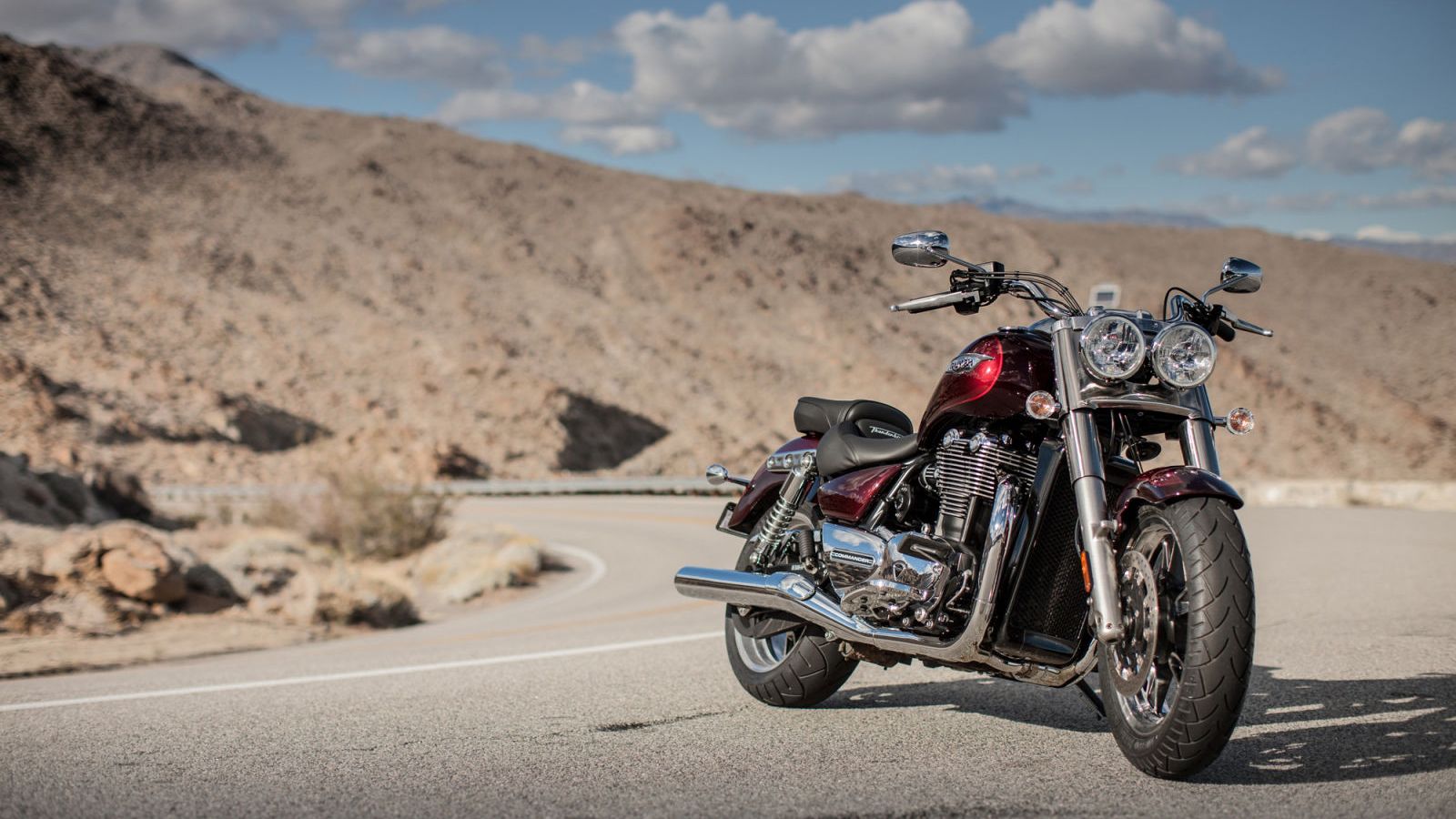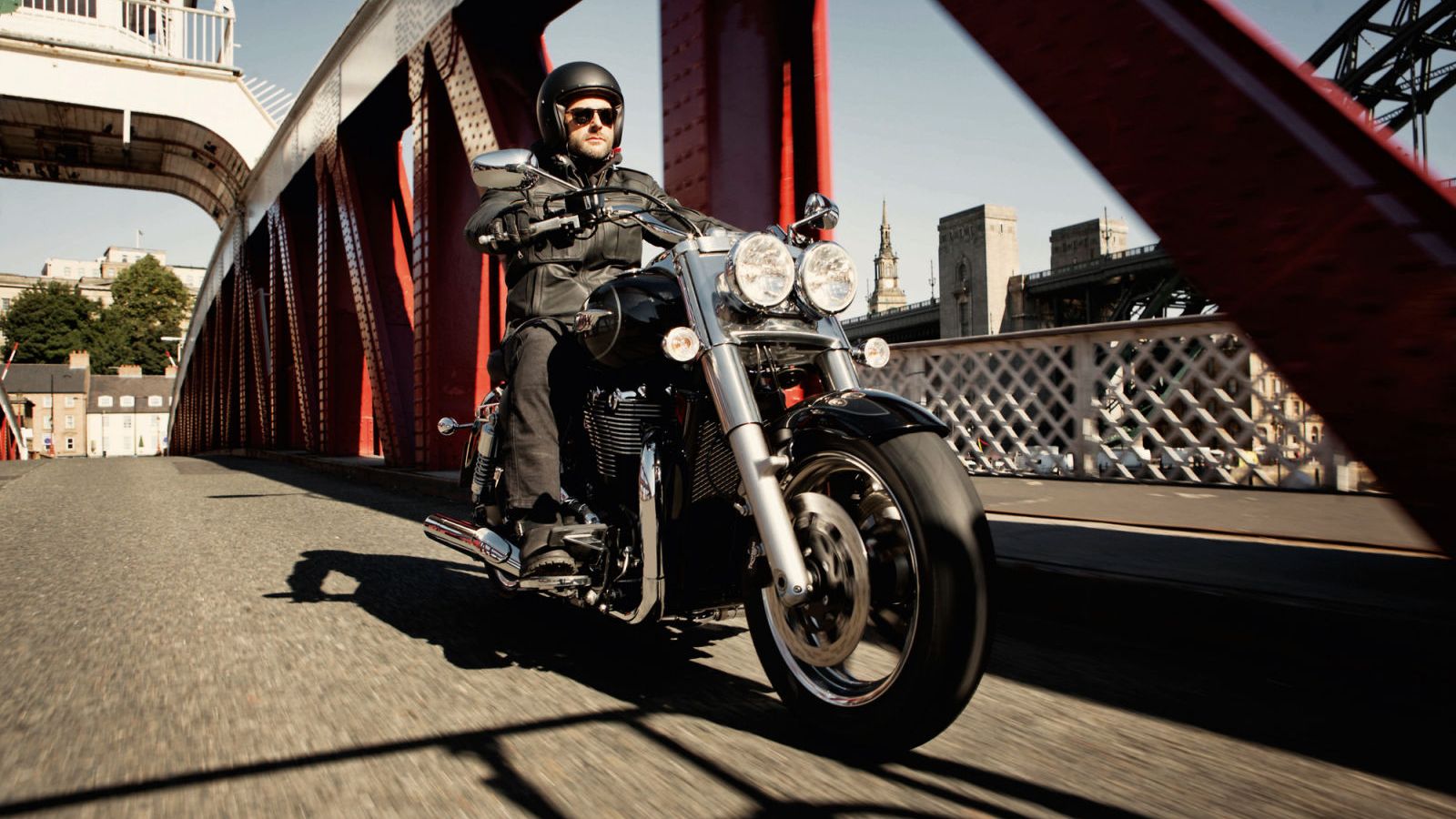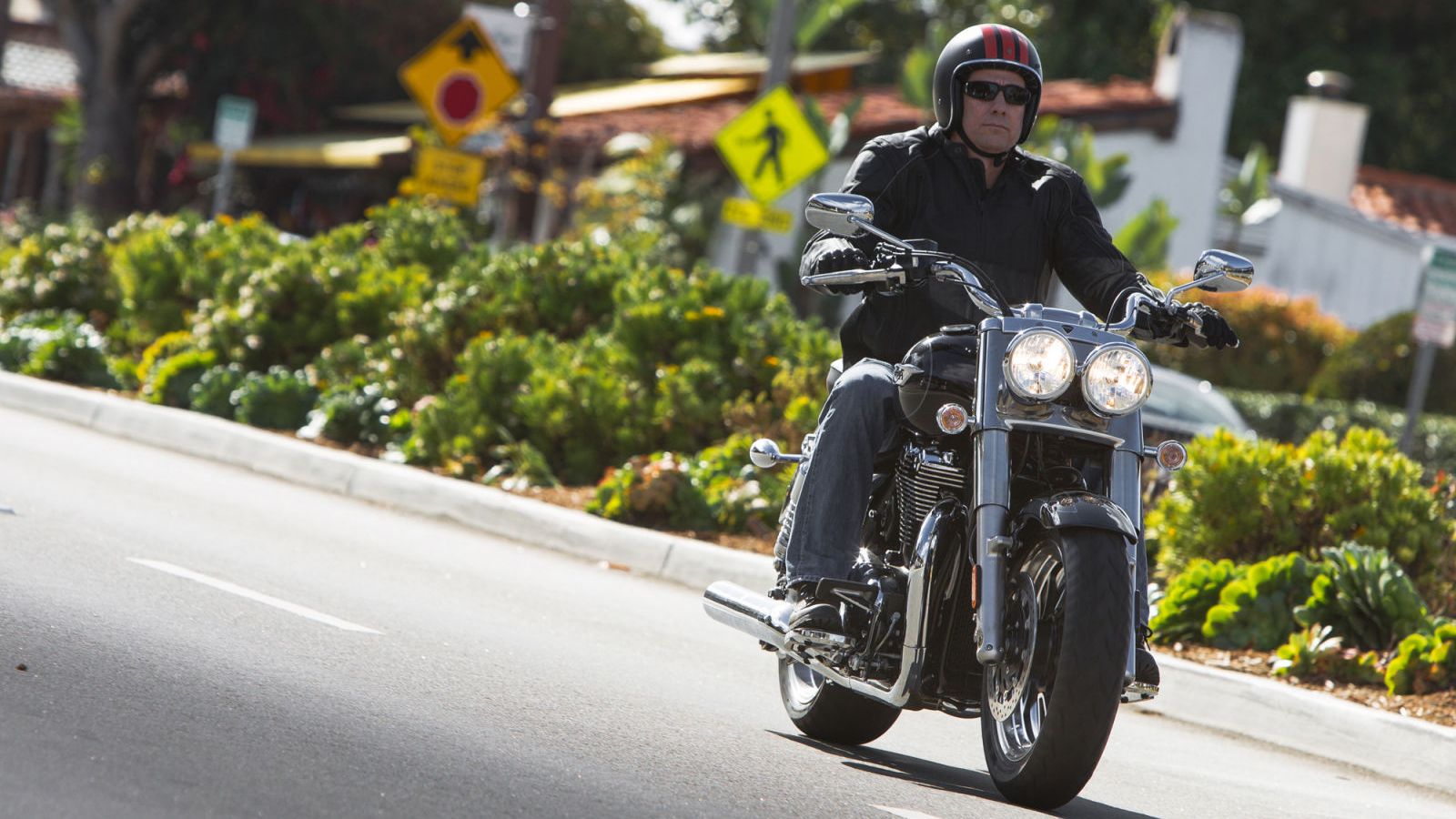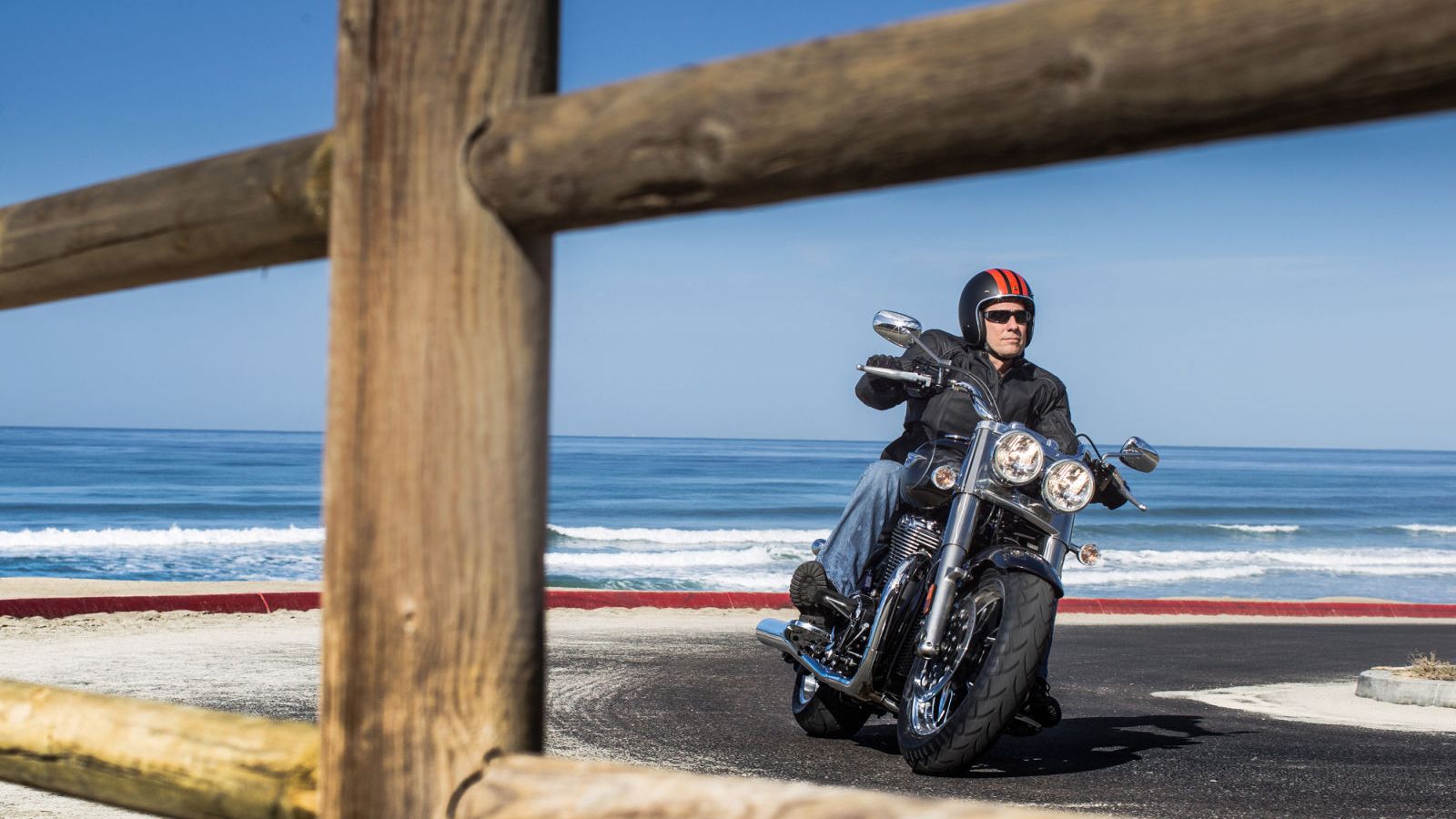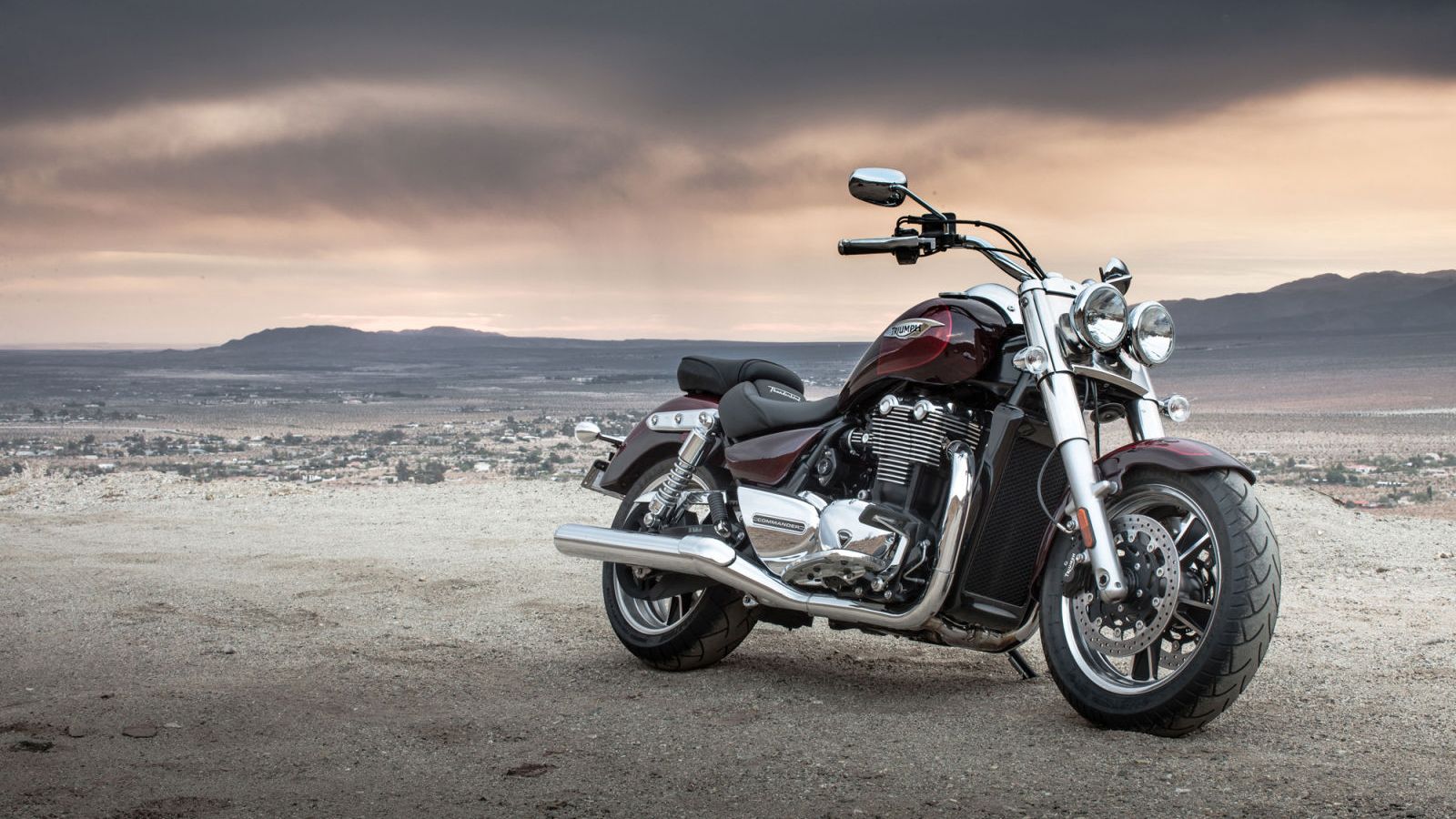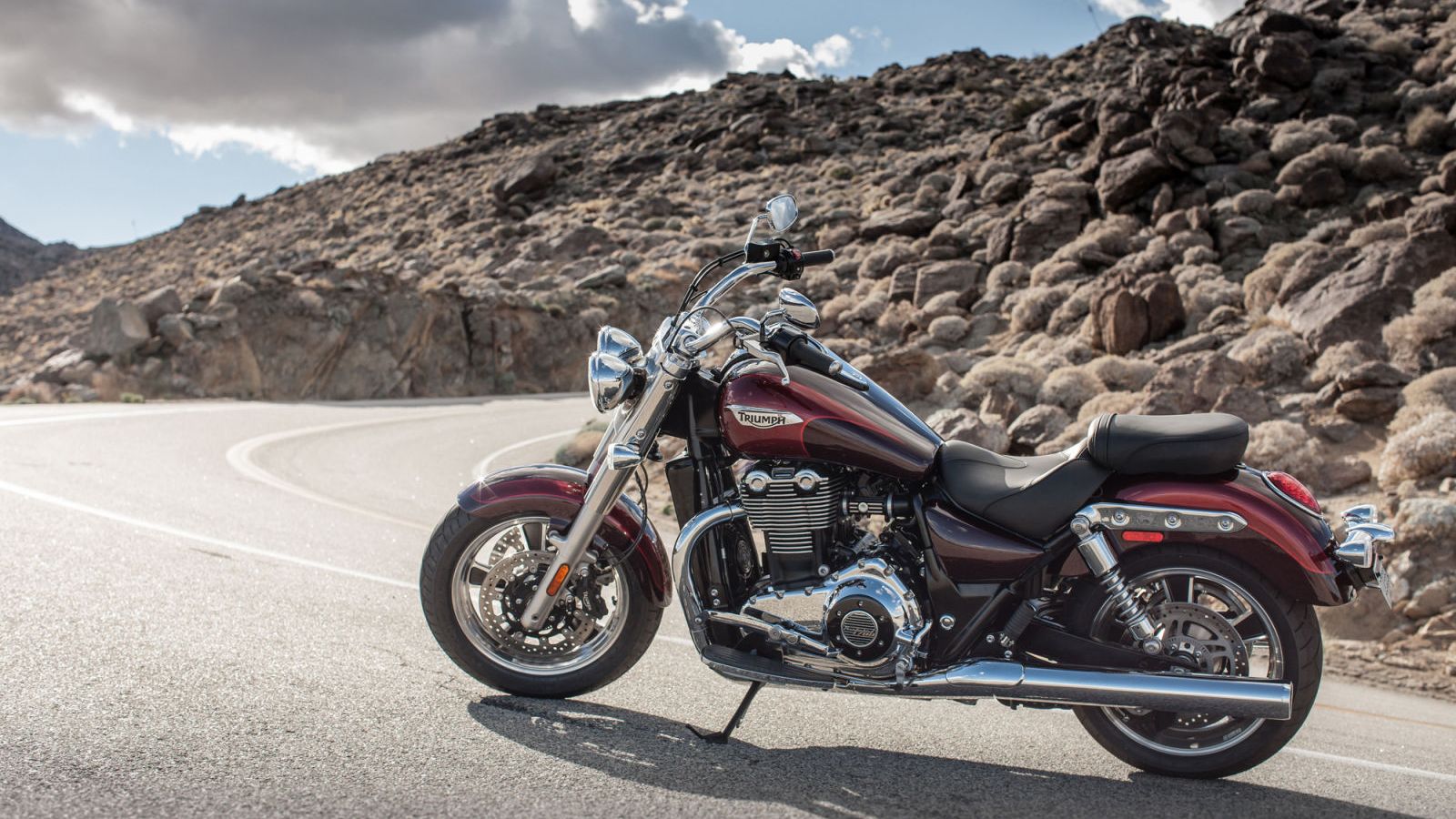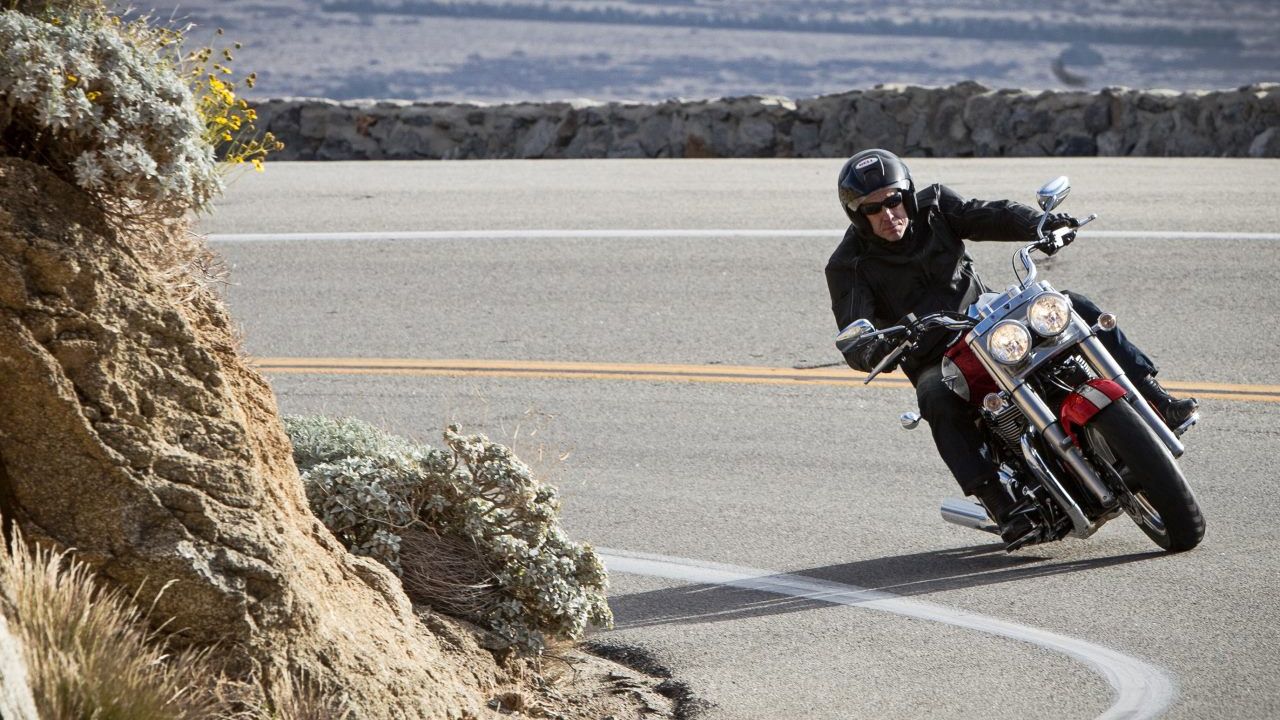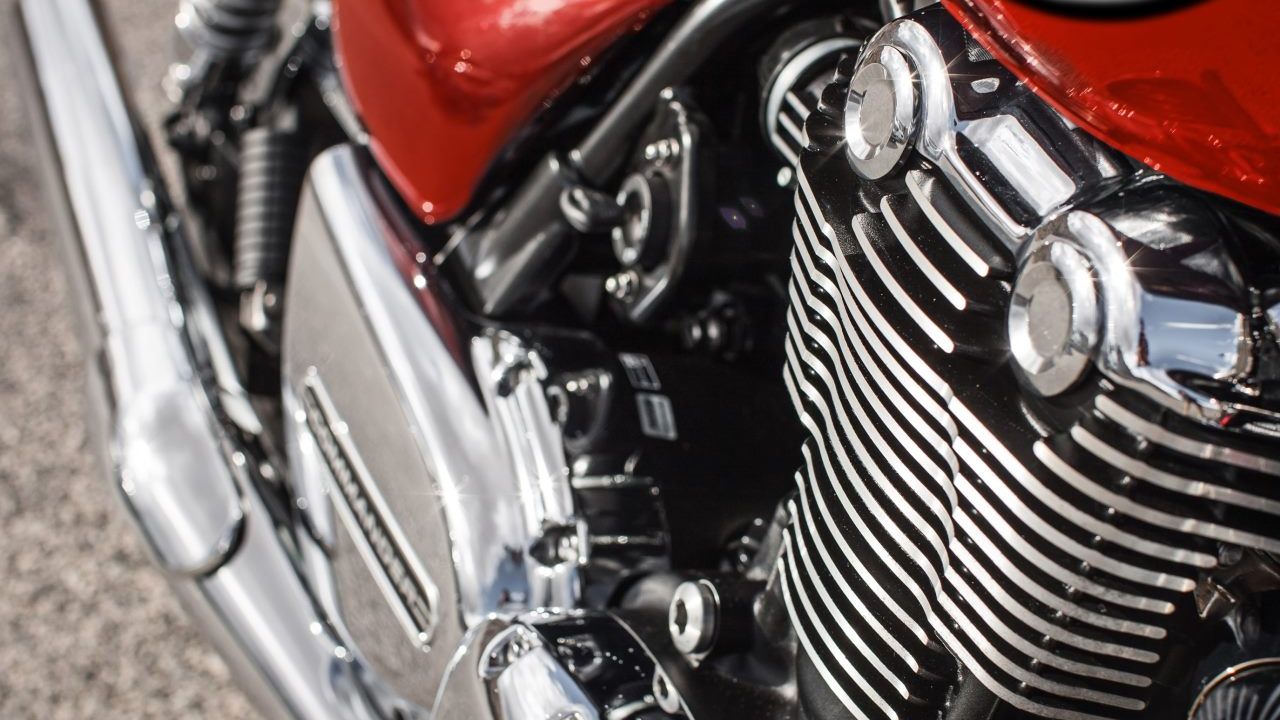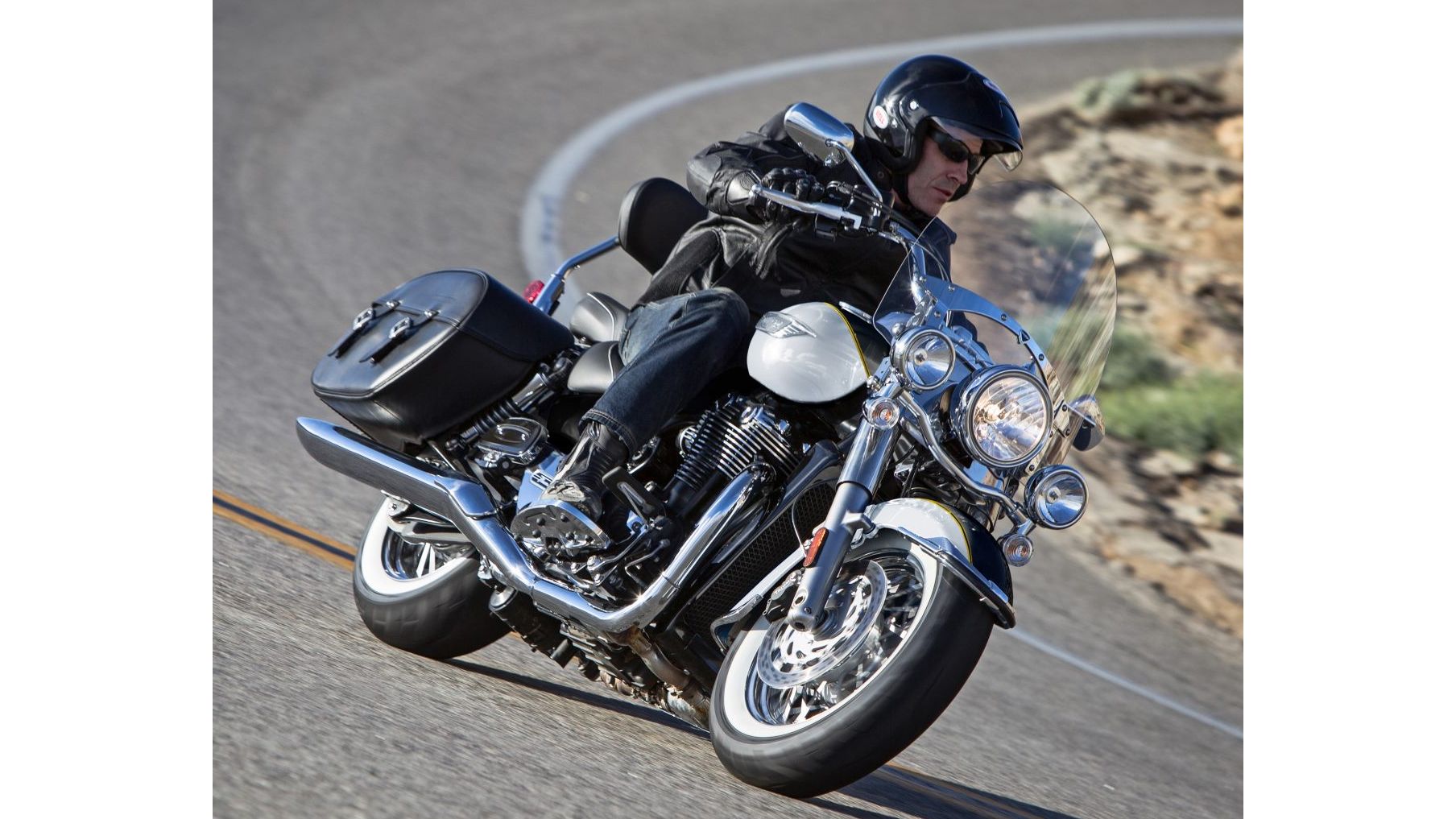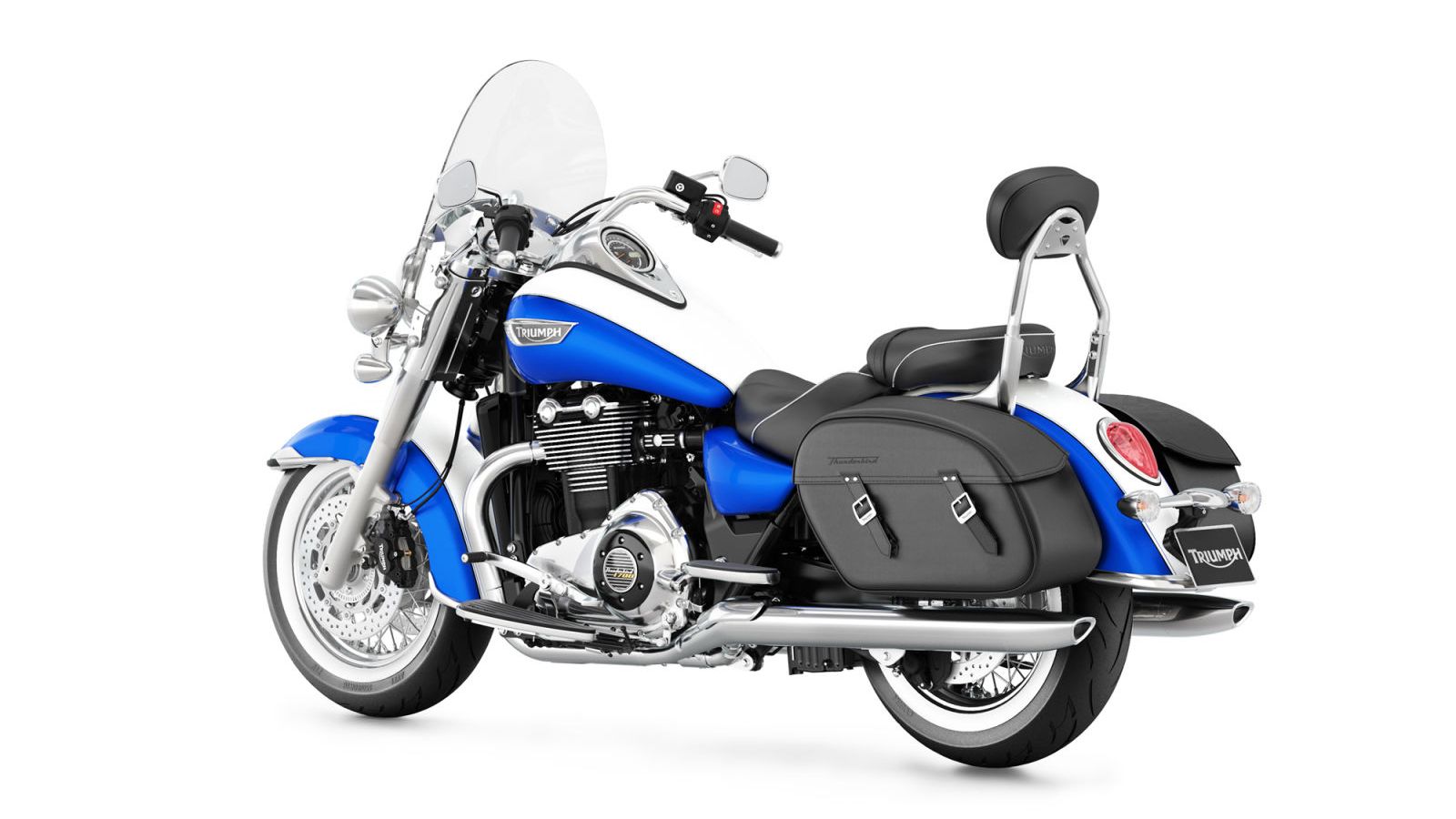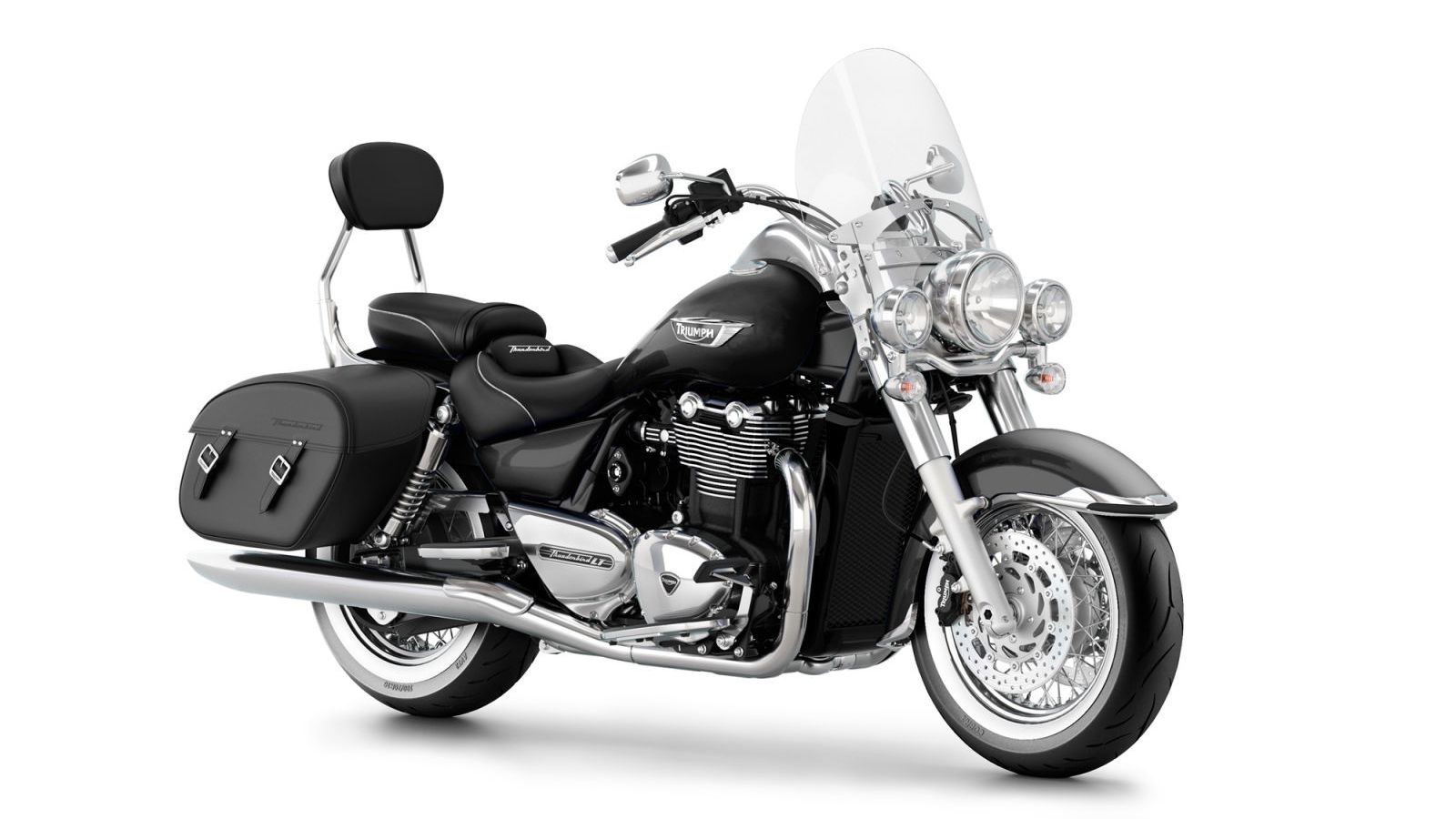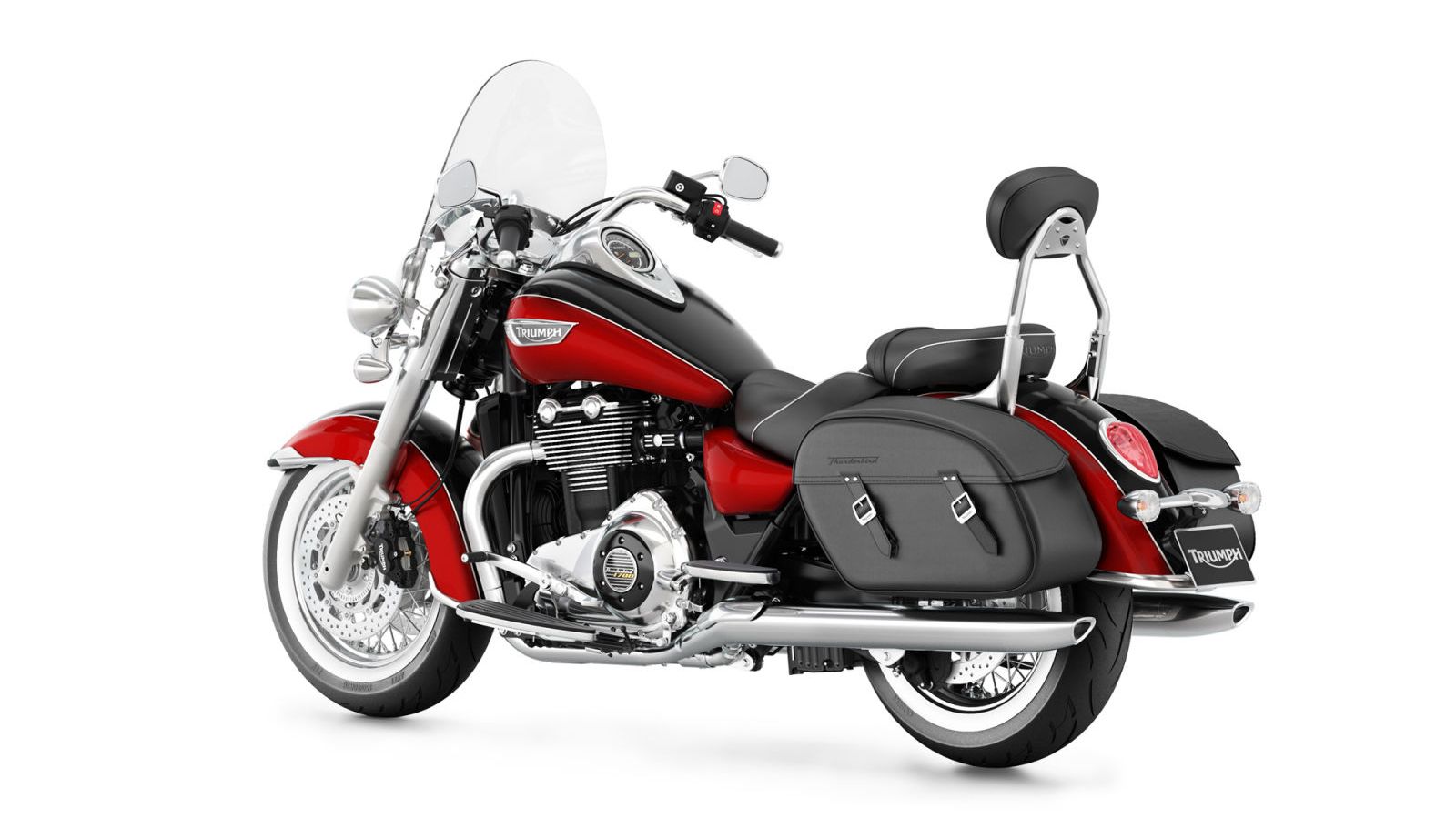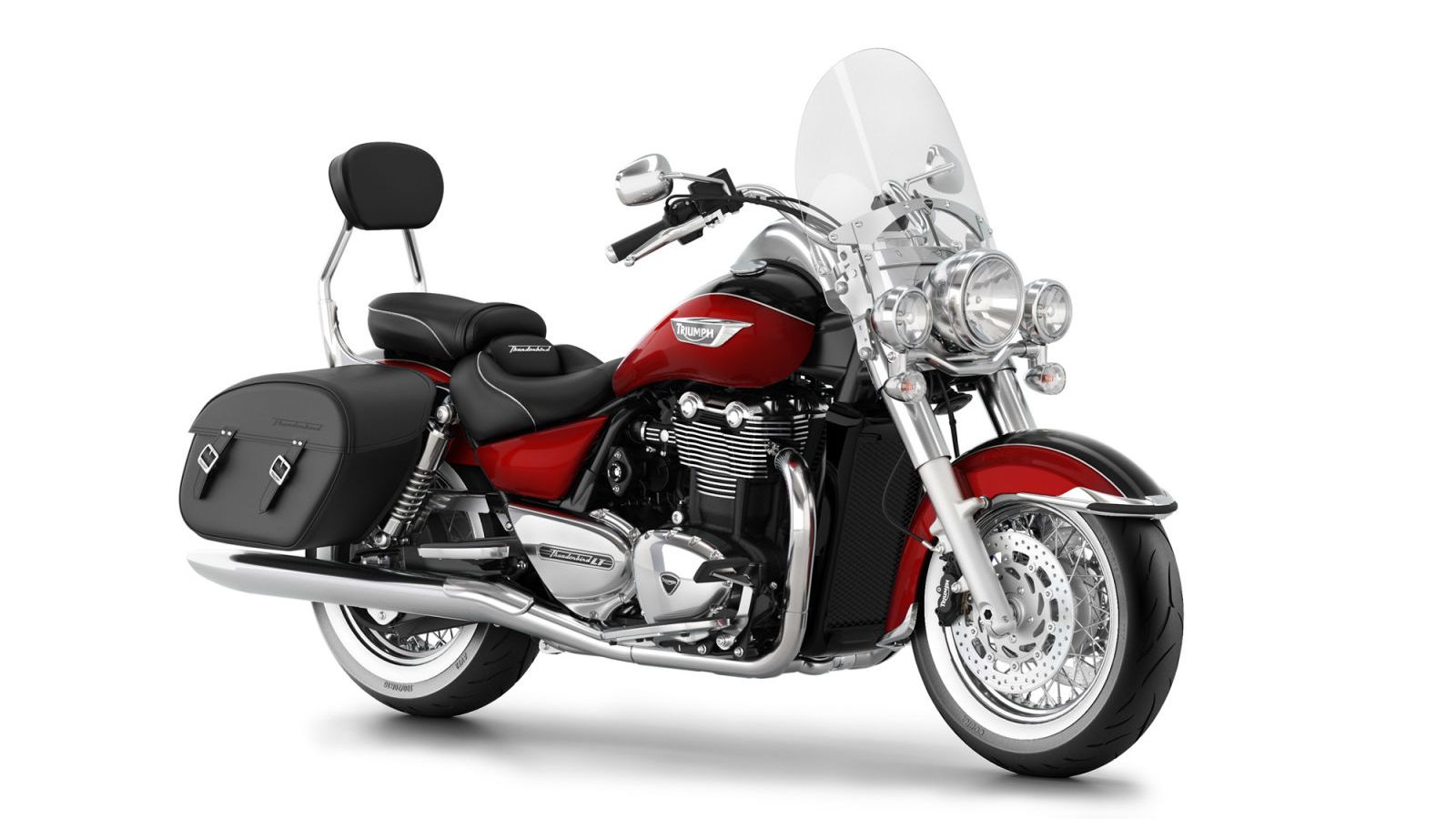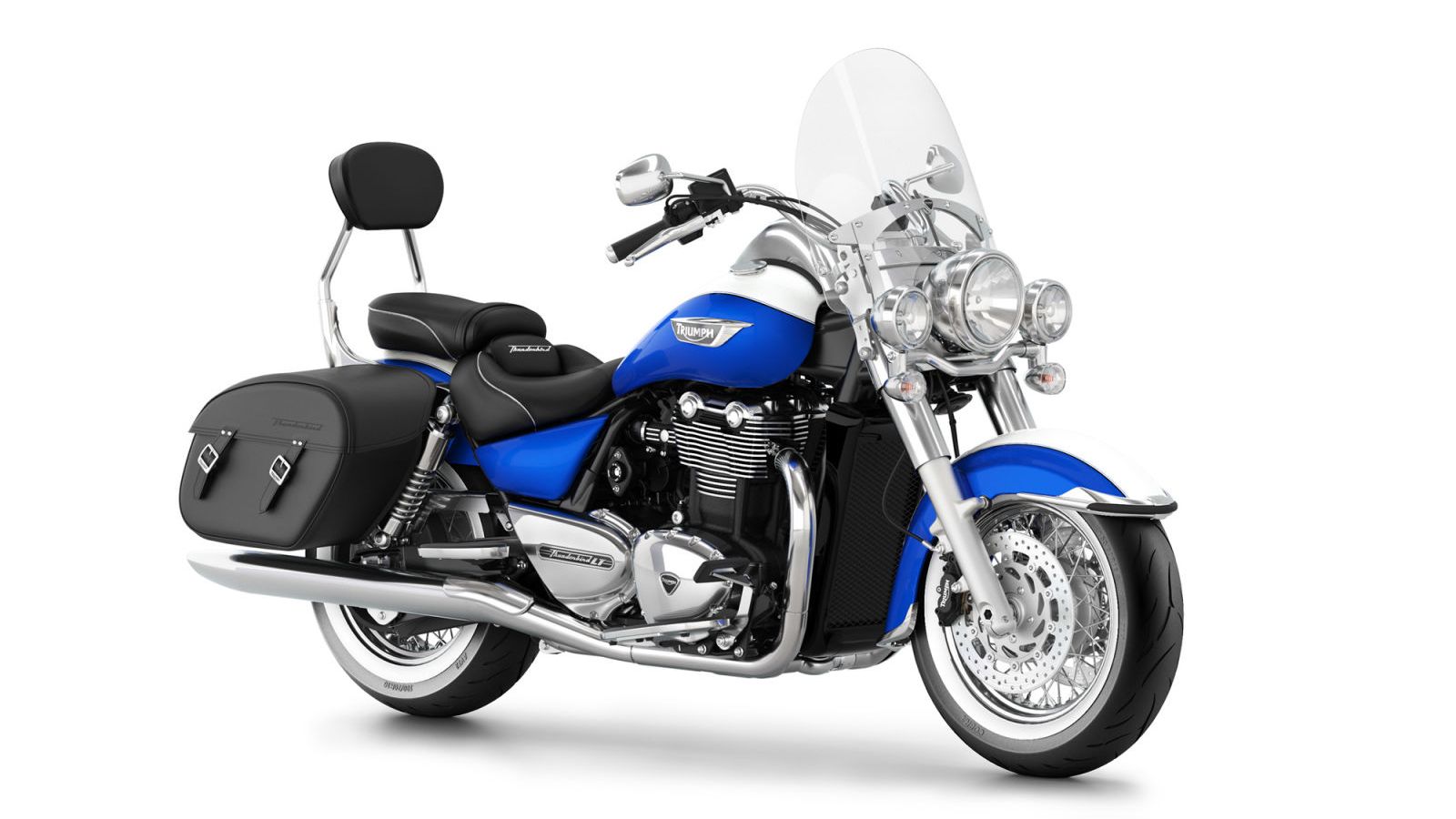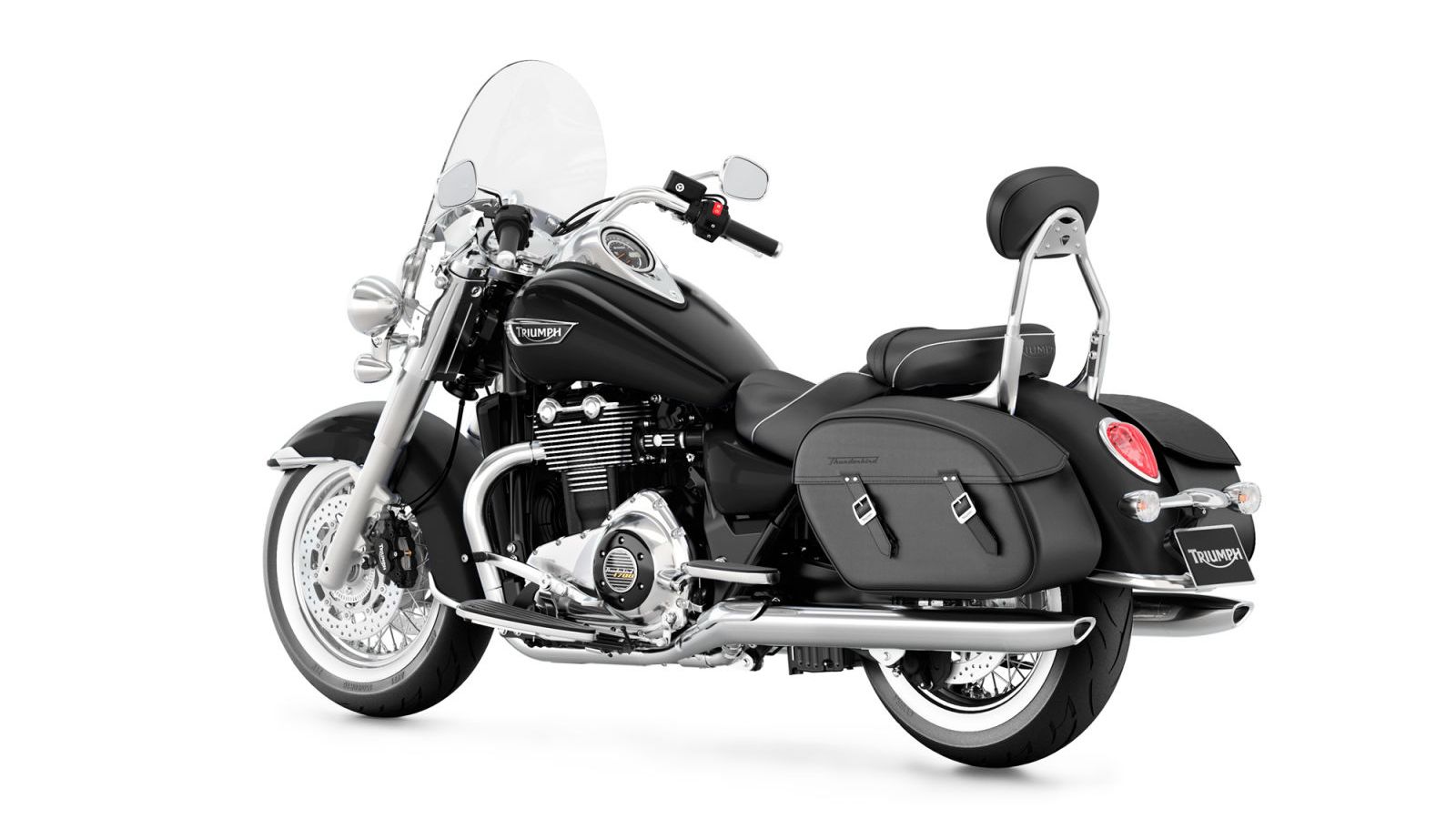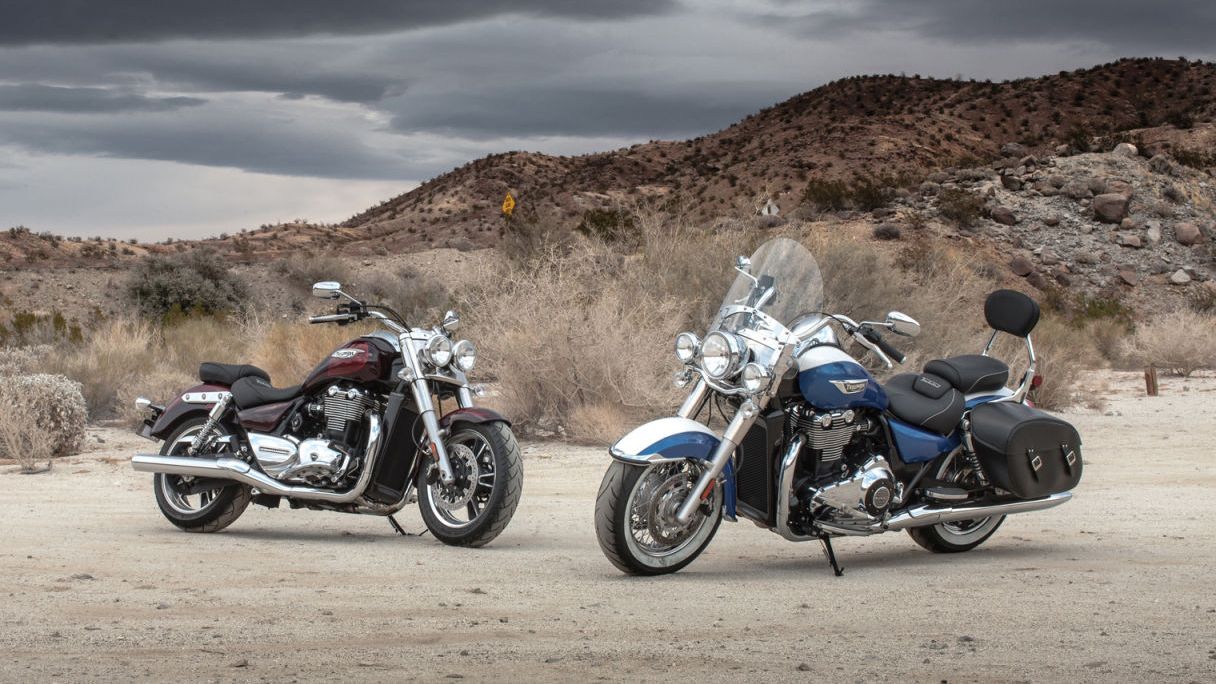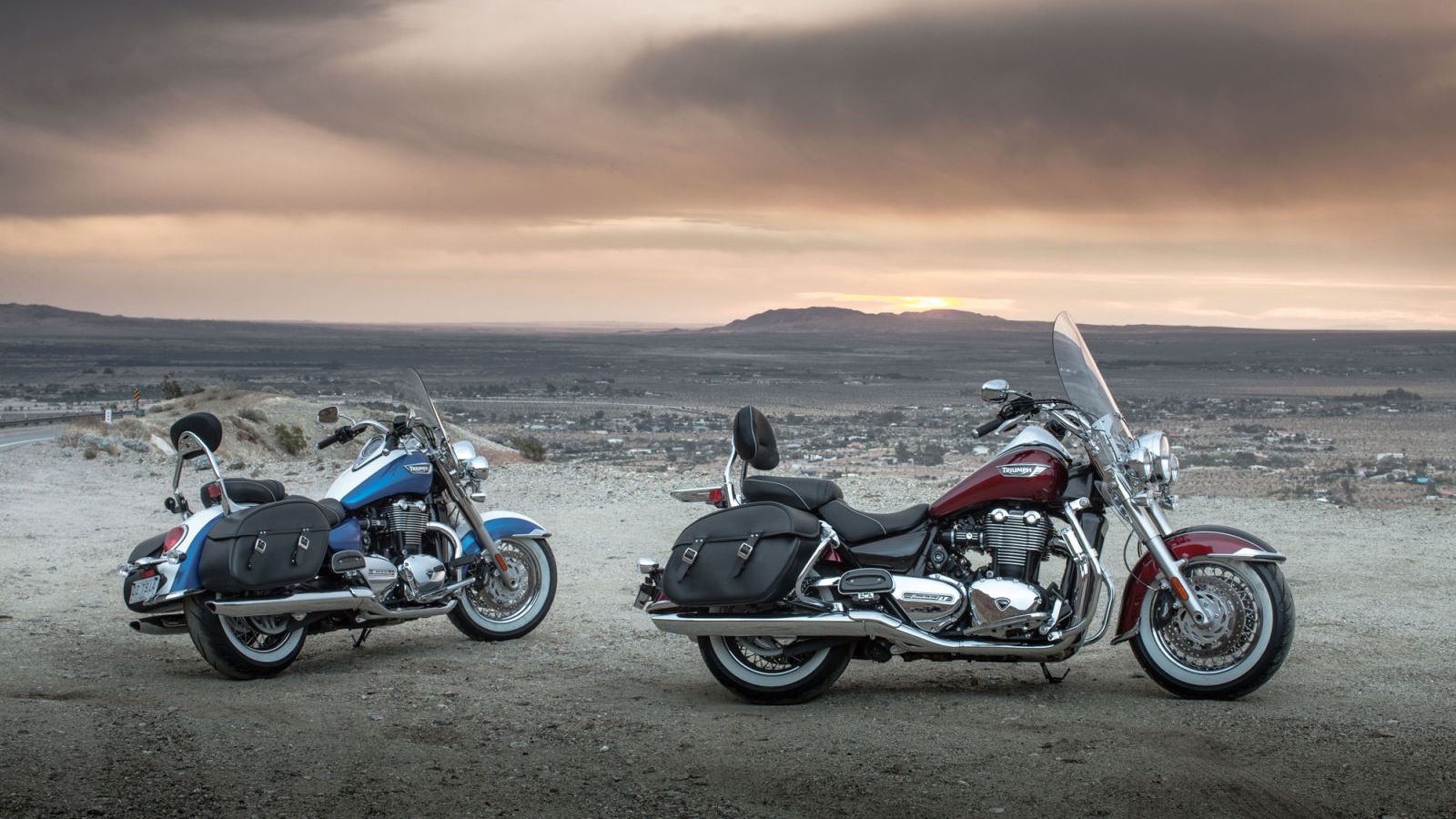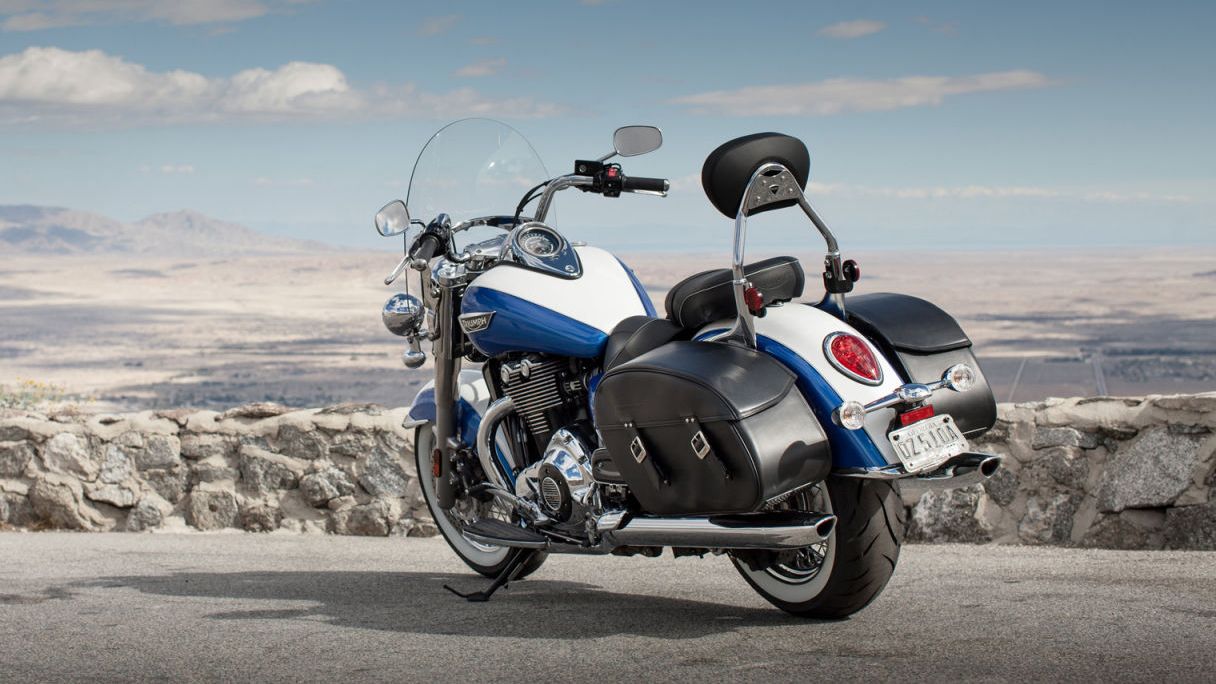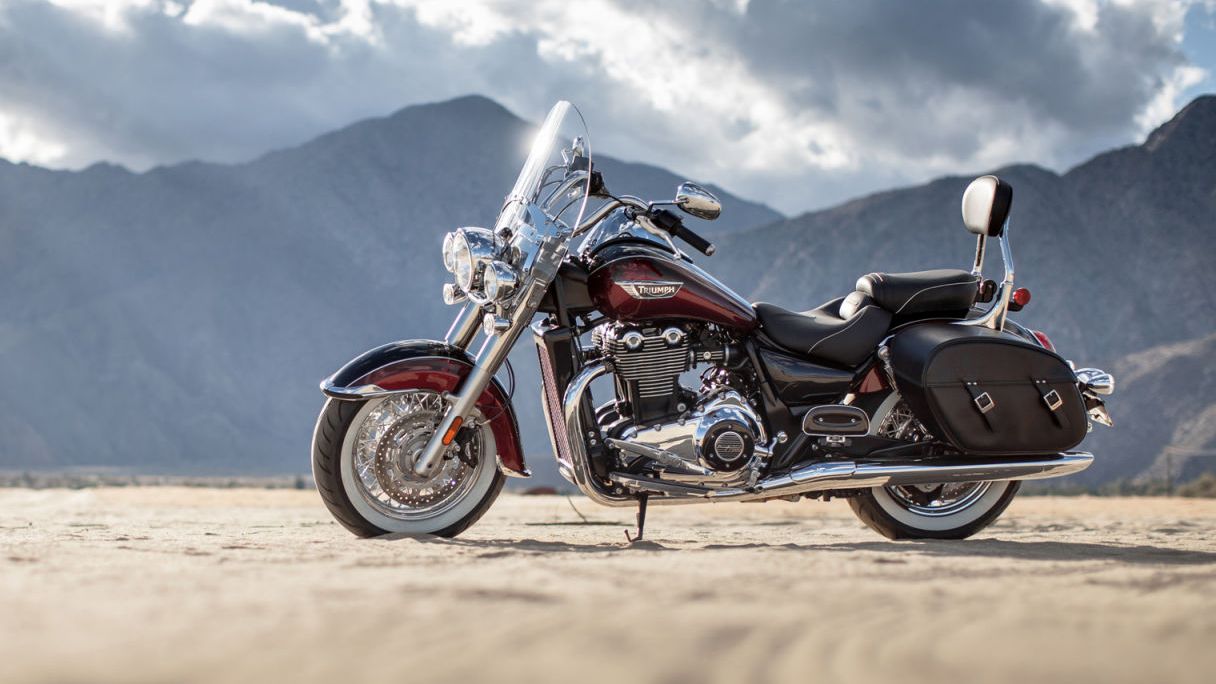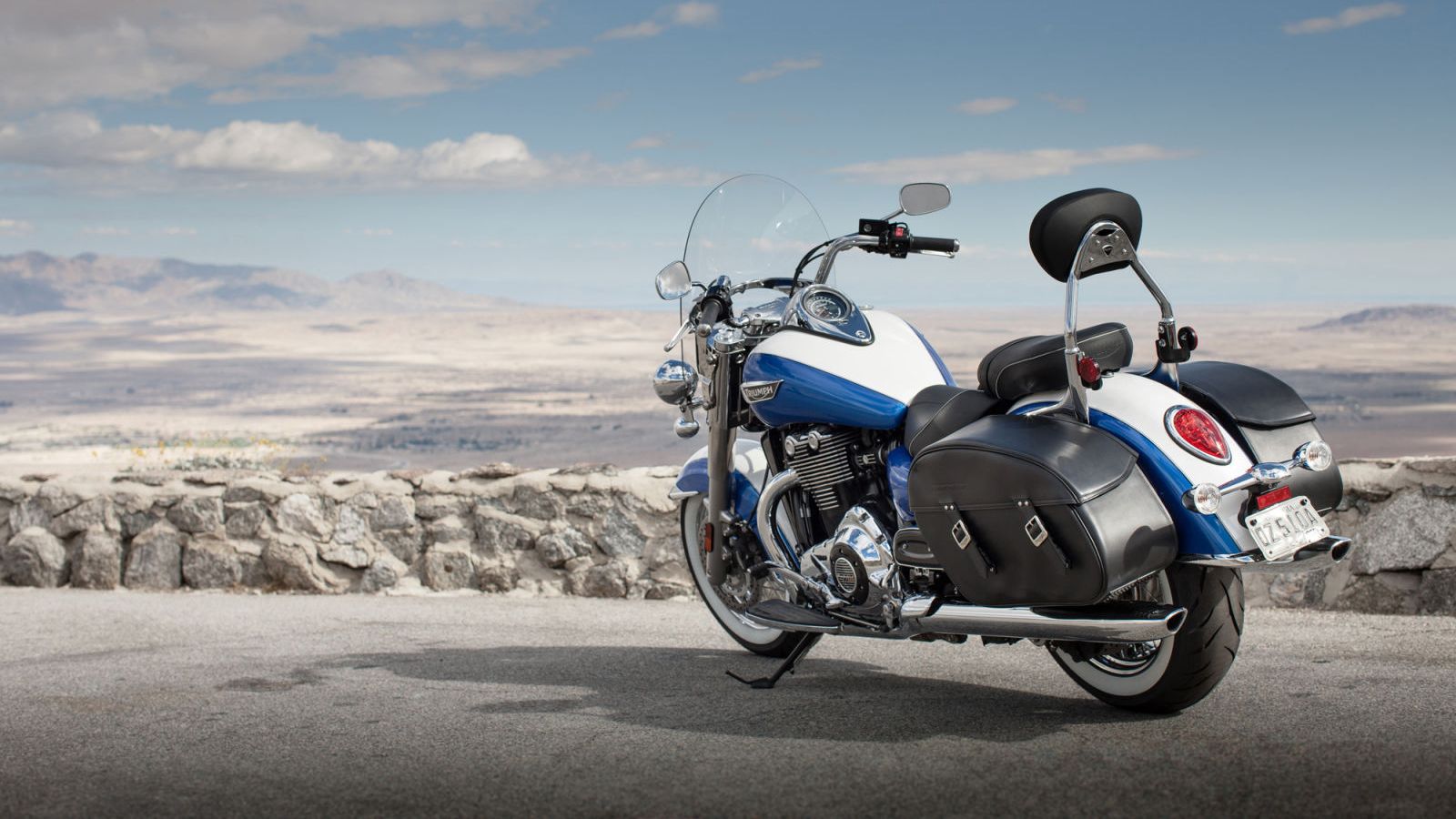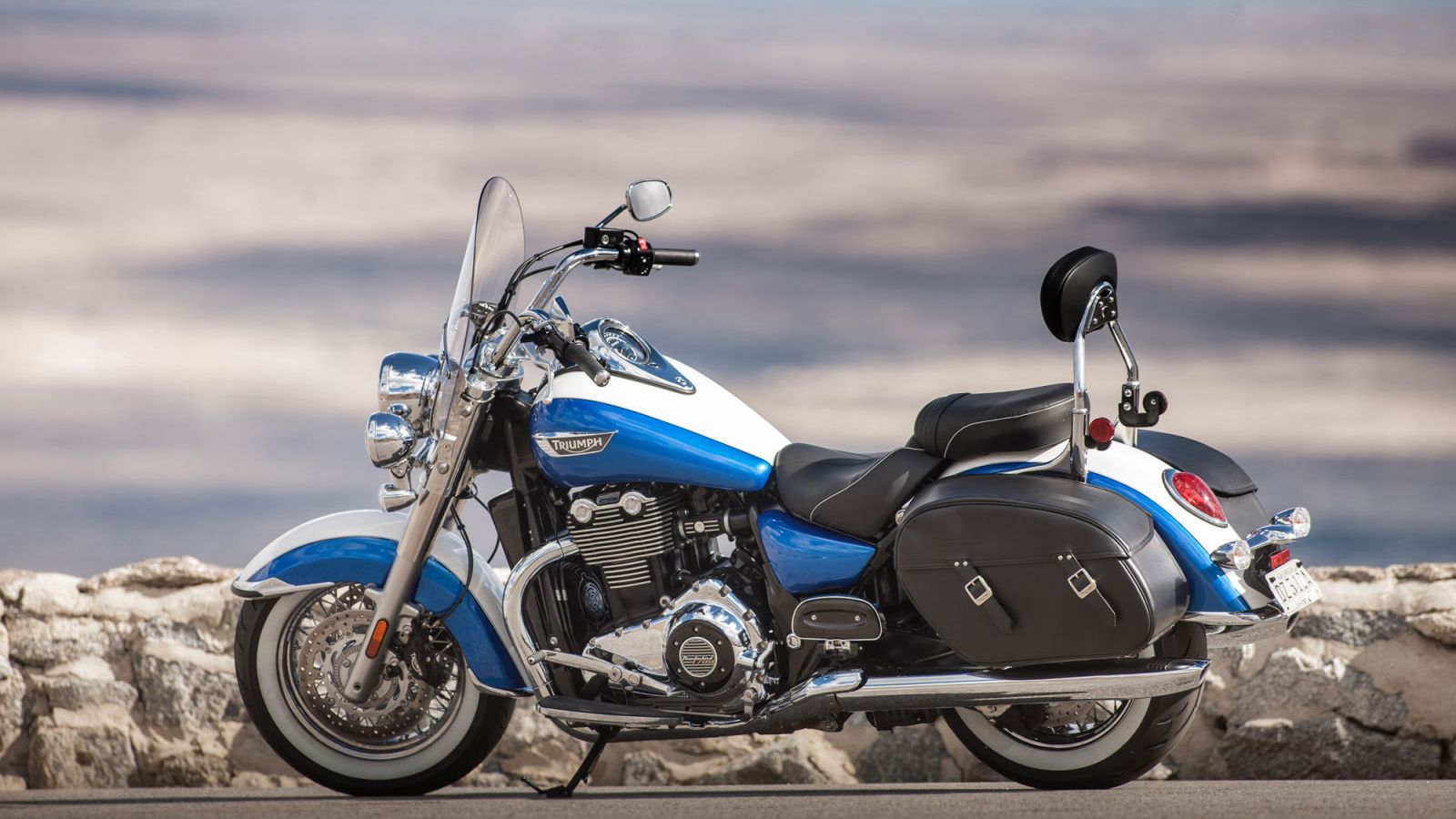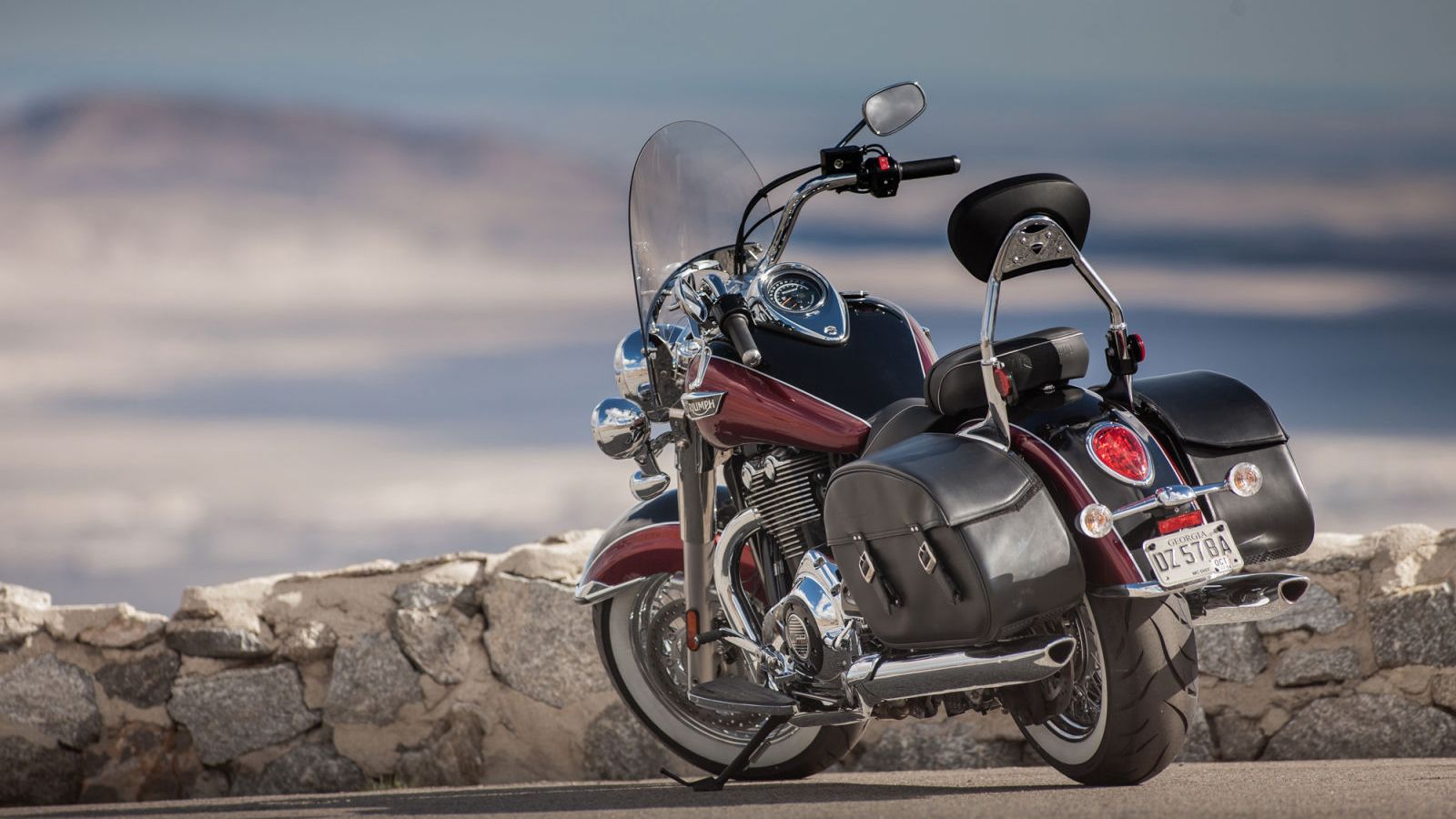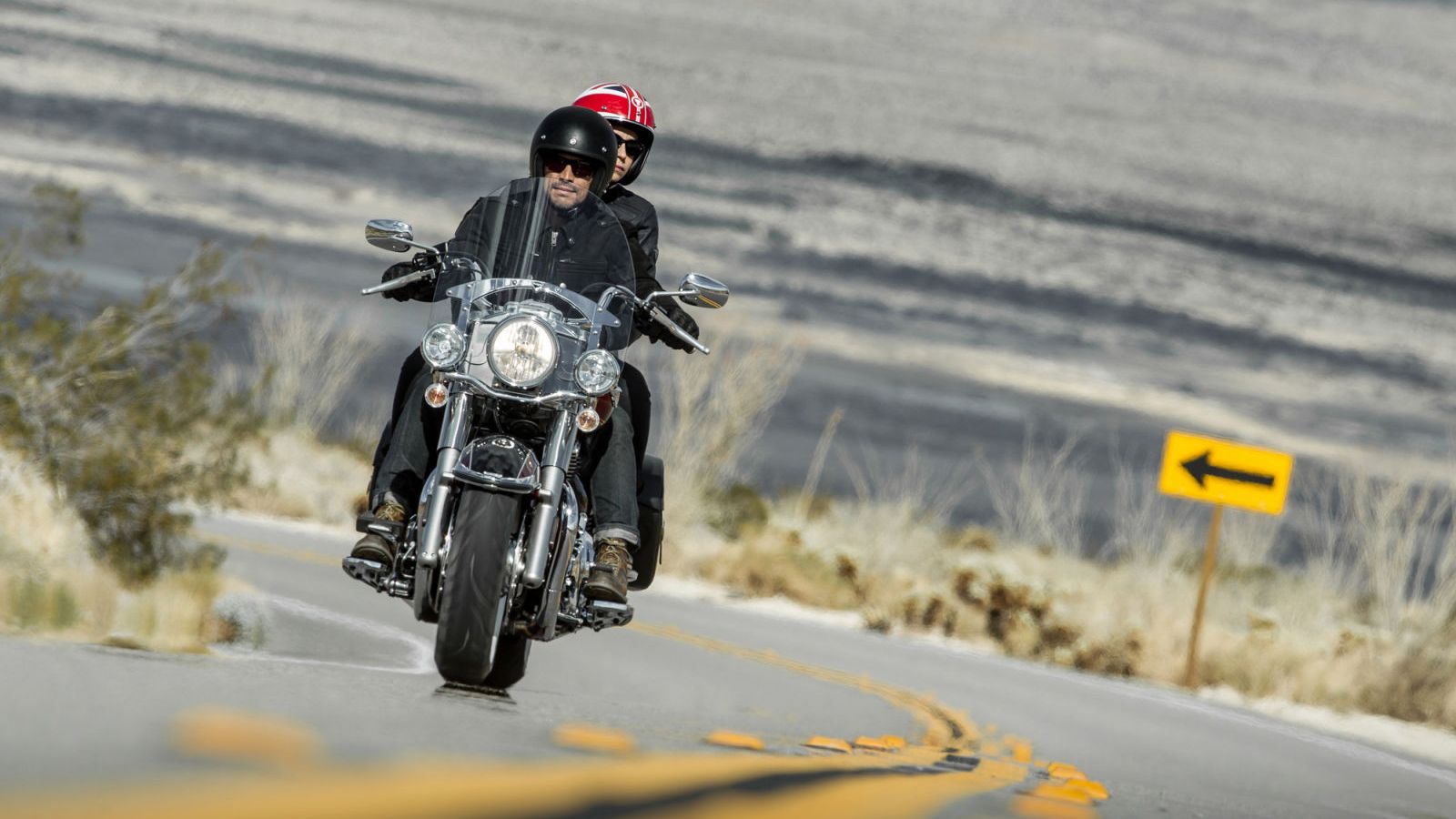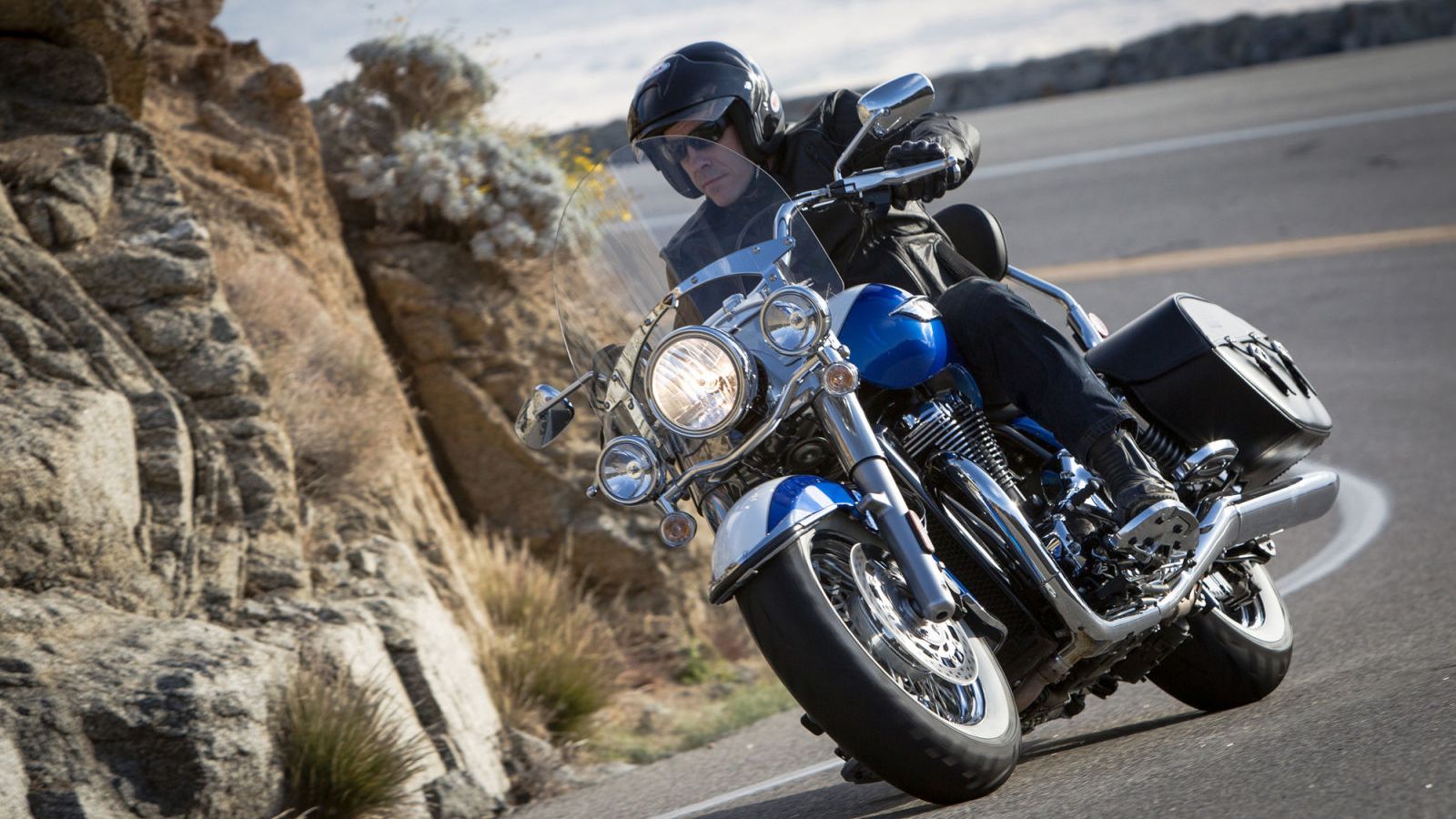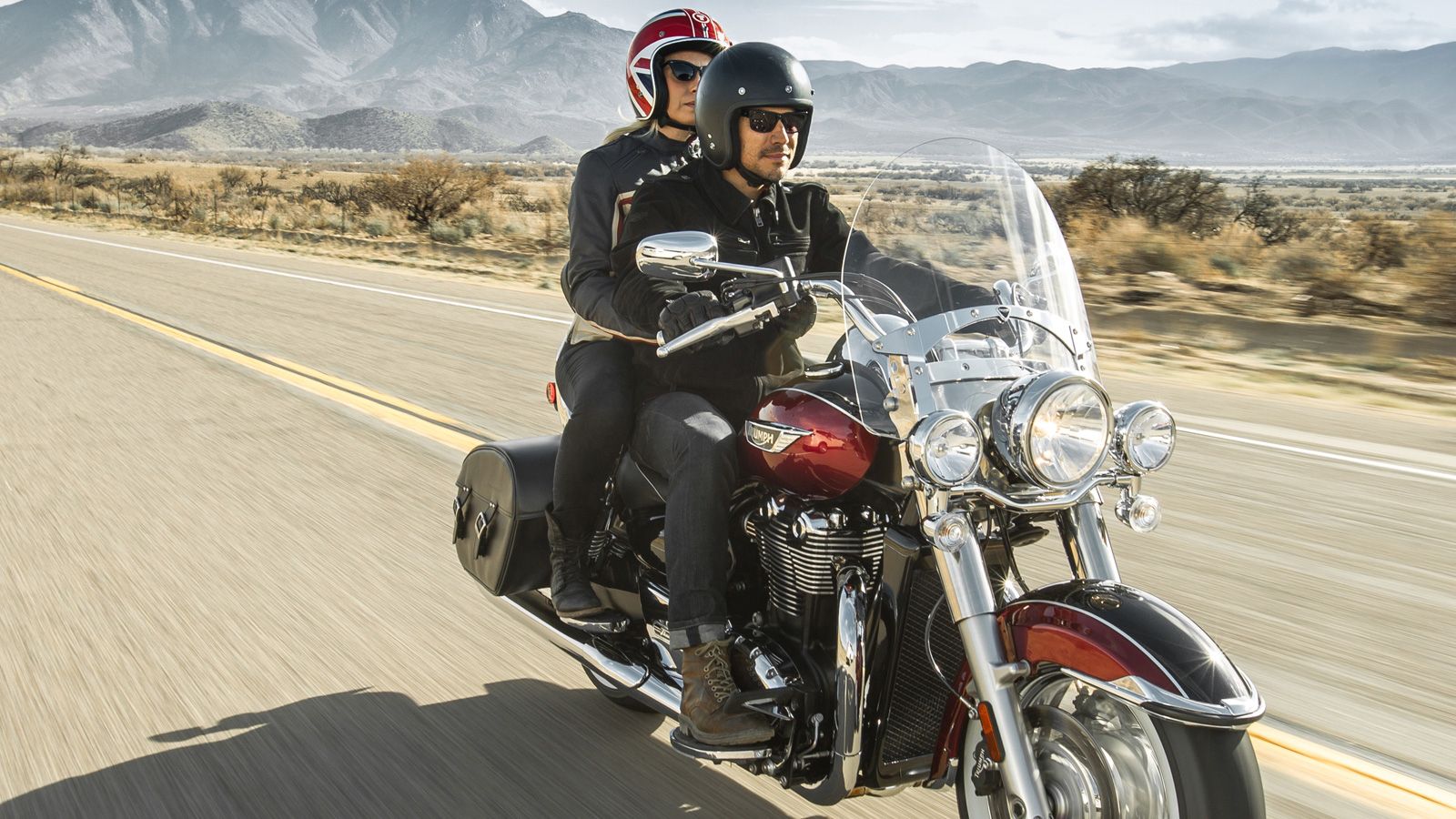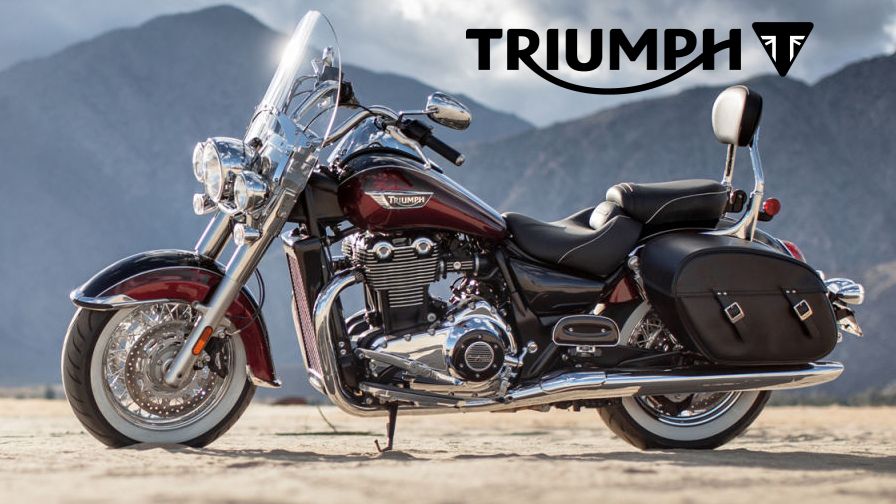Like nearly all of Triumph Motorcycle's->ke1864 current offerings, the Thunderbird->ke3445 family has some very deep roots indeed. A design dreamed up by Edward Turner, the Thunderbird made its debut run from 1949 to 1966, and reappeared in Triumph's lineup a number of times with different engines and designs.
Originally called the 6T “Thunderbird,” the 1950 year-model 6T was made famous with Americans by Hollywood in 1953 when it was immortalized in the Marlon Brando picture The Wild One, and our love affair with the family (and outlaw biker culture) has endured through the years.
Today I want to take a look at the newest Thunderbird range which includes the Commander, Storm and LT, to see if they live up to the name they bear. The word “icon” gets thrown around a lot these days, almost to the point that it has lost some of its impact, but the Thunderbird and its paper dart actually fit the bill. In other words, these three machines have some pretty big shoes to fill. Let's see how they do, shall we?
Continue reading for my review of the Triumph Thunderbird Storm, Thunderbird Commander, and Thunderbird LT.
2016 Triumph Thunderbird Storm / Thunderbird Commander / Thunderbird LT
- Make: Array
- Model: 2016 Triumph Thunderbird Storm / Thunderbird Commander / Thunderbird LT
- Engine/Motor: Parallel-twin
- [do not use] Vehicle Model: Array
Design
The Commander serves as a base model of sorts for the range. It comes in a fairly standard cruiser->ke392 layout with skirted front forks kicked out at a jaunty angle, wide handlebars, and upper lines that drop down the sloped fuel tank to the deep-scoop seat and stadium pillion pad. Viewed in profile, the Thunderbirds look very Softail->ke1819-ish in their lines. Not saying it's a bad thing or even a copycat (like some bikes are, blatantly), just illustrating the general looks of the thing.
The 27.6-inch seat height, wide pullback bars and forward foot controls encourage a relaxed, upright riding position and while both the LT and Commander come with full, floating footboards, the Storm runs with pegs in keeping with its power-cruiser panache.
Triumph went with a near-total blackout finish on the Storm, with only the cooling-fin edges, exhaust, suspension and assorted hardware escaping the paint booth untouched. This ties it in to traditional custom style and lends an intimidating edge to this British stoplight burner. The Commander comes with a bit more in the way of chrome bling, and it carries more sheet metal than the Storm with slightly larger fenders. At the top we have the tour->ke2669-tastic LT with the fullest fenders of the three complete with chrome trim, plus a windshield, bags and a passenger backrest. Instead of the dual, symmetrical headlights like its siblings, the LT runs a large, central headlight flanked by a pair of pimp lights to aid in seeing and being seen.
Overall, the Thunderbird flock looks like relatively standard American fare until your gaze lands on that distinctly British engine; but that's OK, the Thunderbird has always been geared for the U.S. market. One thing's for sure, it certainly cuts a much different figure than the other Triumph families.
Chassis
A twin-spine frame made up of mild, tubular steel serves as the standing bones in the traditional, dual-downtube, double-cradle format. Not only does this provide some protection for the engine from below, it fits the cruiser motif better than a Trellis, or some other stressed-engine arrangement. The dual-side swingarm completes the assembly both structurally and visually, because let's face it, one of those fandangled, one-sided swingarms just wouldn't look right here. Plus, it would displace the shocks and really change the look.
Steering geometry varies model to model. The LT comes with the shortest angle at 29.9 degrees with 5.2 inches of trail. In the middle of the range we have the Commander with a 30.1-degree rake and 5.3 inches of trail, and at the long end of the spectrum, the Storm pushes the forks out to 32 degrees with 5.9 inches of trail. These figures give us some fairly stable tracking at speed and when passing through the pressure wave in front of big vehicles on the highway, and the extra rake on the Storm just adds to its custom appeal.
All three models come with the same 47 mm front end from Showa. The Storm seems to have a smaller front end, but this is an optical illusion created by the skirting around the upper fork tubes and tripletree on the Commander and LT. Front suspension compression and rebound values are fixed, but the 120 mm fork travel should be sufficient for most civilized surfaces. The Commander and LT sport chromed, Showa rear shocks with adjustable spring preload and 4.27 inches of travel. On the Storm, the blackout treatment makes its way onto the Showa shock springs, and they also come with adjustable preload but only 3.74 inches of travel.
The Storm rolls on cast rims with a 19 incher up front and a 17 incher in the back, and that lack of symmetry adds to its custom->ke296 flair. A pair of 17-inch cast rims round out the rolling chassis for the Commander, and the LT rolls on a set of chrome laced wheels. The LT also mounts the whitewalls on the outside for a little extra charm.
Brakes are consistent across the board with dual, four-pot, Nissin calipers binding dual, 310 mm front discs, and a Brembo, two-pot caliper pinching a 310 mm rear disc. ABS protection comes as part of the standard equipment on all three bikes.
Drivetrain
Triumph touts the Thunderbird mill as the biggest parallel-twin engine ever produced. Bore and stroke measures out at 107.1 mm and 94.3 mm respectively, and add up to a total of 1,699 cc. Unlike the twingles of yesteryear, this engine runs an uneven, 270-degree firing interval with something of a lope to the exhaust note.
As usual, liquid cooling is a mixed blessing. On one hand, you have a big radiator to mount in a very conspicuous position, on the other hand, the water jacket helps mitigate the mechanical thrashing noises within the cases. A progressive throttle linkage and multi-point fuel injection controls the induction to deliver around 37 mpg in the city and 40 mpg on the highway.
Performance numbers on the Commander and LT are the same with 94 horsepower at 5,400 rpm and 111 pound-feet at 3,550 rpm, not too shabby for a cruiser/tourbike, but the Storm takes it up a notch with 98 ponies and 115 pounds of grunt. Since all else seems equal across the board, I am going to guess this power difference is due to some magic in the engine management programming. No matter where it comes from, this little bit of lagniappe is just the icing on the cake for the Storm.
All three models come with a wet clutch and six-speed gearbox with a belt-and-pulley drive to make the final connection to the rear wheel.
Price
Prices vary according to the paint package you decide on. All three models are available in Jet Black for the lowest price within each range; $15,000 for the Storm, $16,000 for the Commander and $17,000 for the LT. The Storm can be had in Lava Red for another $250, while the Commander comes in Lithium Flame / Frozen Silver or Phantom Black / Storm Gray for another five bills. The LT can be had shot in Lava Red / Phantom Black or Crystal White / Phantom Black, also for another $500.
Competitor
Given Triumph's history on U.S. soil and the overall looks and stance of the Thunderbird LT, I felt it fair to just go ahead and compare it to one the the most beloved of the Harley-Davidson cruiser/half-baggers, the Heritage Softail Classic. All it takes is a glance to see they both fit within the same genre, and would appeal to many of the same buyers, so let's see how they stack up once we get past the skin-deep first impression.
The front ends are nearly identical with large diameter, shrouded front forks, passing lamps and a quick-release windshield, and the upper lines are nearly identical all the way back to the passenger backrest. Naturally, the Heritage saddlebags come with more “Old West” in evidence with tasseled conchos and chrome studs, a treatment that makes it onto the saddle skirt as well. Softails are built to emulate the old rigid frame, but the bags on the Heritage screen most of the triangular swingarm from view, and so much of that effect is lost.
Harley doesn't use its biggest engine in the Heritage, but instead runs its air-cooled, 1,689 cc Twin Cam 103 and surrenders 10 cubes to the 1699 cc Thunderbird mill. Triumph sets the bar high at 111 pound-feet of torque, a bit higher than the Twin Cam 103 can manage with only 97.4 pounds of grunt.
Triumph keeps up the pressure all the way to the till with a $16,000 sticker that edges out the Heritage with its $17,349 price tag. This is in basic black for both bikes, and while the LT can be had in a few other colors for a little more cheddar, the King of Paint offers a number of paint packages that can carry the price as high as $18,299.
He Said
“I gotta say I'm really feeling the love for the new Thunderchicken. I think Trumpet did a good job of toeing the family line, though I would prefer to see an air-cooled mill sans radiator for a cleaner, purer look, but maybe that's just me. All in all, I expect the Thunderbird family to do fairly well in the U.S. market against the available competitors.”
She Said
My wife and fellow motorcycle writer, Allyn Hinton, says, “Lots of torque that comes on really early. Even at low speeds, you give it a twist and it leaps forward. The forward controls aren't too far forward, so you feel like your feet are still in the same zip code. The pull-back handlebars put you in a comfortable cruiser seating position and the Thunderbirds have some of the beefiest brakes I think I've seen on a big cruising bike -- very positive braking.”
Specifications
|
MODEL: |
Thunderbird Storm |
Thunderbird Commander |
Thunderbird LT |
|
ENGINE: |
|||
|
TYPE: |
Liquid-cooled, DOHC, Parallel-twin, 270º firing interval |
Liquid-cooled, DOHC, Parallel-twin, 270º firing interval |
Liquid-cooled, DOHC, Parallel-twin, 270º firing interval |
|
CAPACITY: |
1699cc |
1699cc |
1699cc |
|
BORE: |
107.1mm |
107.1mm |
107.1mm |
|
STROKE: |
94.3mm |
94.3mm |
94.3mm |
|
SYSTEM: |
Multipoint sequential electronic fuel injection, progressive linkage on throttle |
Multipoint sequential electronic fuel injection, progressive linkage on throttle |
Multipoint sequential electronic fuel injection, progressive linkage on throttle |
|
EXHAUST: |
Chromed twin-skin stainless steel 2 into 1 into 2, tandem large-volume catalysts in centralized catbox, chrome-plated exhaust |
Chromed twins-kin stainless steel 2 into 1 into 2, tandem large-volume catalysts in centralized catbox, chrome-plated exhaust |
Chromed twin-skin stainless steel 2 into 1 into 2, tandem large-volume catalysts in centralized catbox, chrome-plated exhaust |
|
FINAL DRIVE: |
Toothed Belt |
Toothed Belt |
Toothed Belt |
|
CLUTCH: |
Wet, multi-plate |
Wet, multi-plate |
Wet, multi-plate |
|
GEARBOX: |
6-speed, helical type 2nd - 6th |
6-speed, helical type 2nd - 6th |
6-speed, helical type 2nd - 6th |
|
OIL CAPACITY: |
1.1US Gallon |
1.1US Gallon |
1.1US Gallon |
|
CHASSIS: |
|||
|
FRAME: |
Tubular Steel, twin spine |
Tubular Steel, twin spine |
Tubular Steel, twin spine |
|
SWINGARM: |
Twin-sided, steel |
Twin-sided, steel |
Twin-sided, steel |
|
FRONT WHEELS: |
Cast aluminium alloy 5-spoke 19 x 3.5 in |
Cast aluminum alloy 5-spoke 17 x 3.5 in |
Cast aluminum alloy 56-spoke 16 x 3.5 in |
|
REAR WHEELS: |
Cast aluminum alloy 5-spoke 17 x 6 in |
Cast aluminum alloy 5-spoke 17 x 6 in |
Cast aluminum alloy 56-spoke 16 x 3.5 in |
|
FRONT TIRES: |
120/70 R19 |
140/75 ZR17 |
150/80 R16 |
|
REAR TIRES: |
200/50 ZR17 |
200/50 ZR17 |
180/70 R16 |
|
FRONT SUSPENSION: |
Showa 47mm forks with black lowers. 120mm travel |
Showa 47mm forks. 120mm travel |
Showa 47mm forks. 120mm travel |
|
REAR SUSPENSION: |
Showa black spring twin shocks with 5 position adjustable preload, 95mm rear wheel travel |
Showa chromed spring twin shocks with 5 position adjustable preload. 95mm rear wheel travel |
Showa chromed spring twin shocks with 5 position adjustable preload. 95mm rear wheel travel |
|
BRAKES FRONT: |
Twin 310mm floating discs. Nissin 4-piston fixed calipers, ABS |
Twin 310mm floating discs. Nissin 4-piston fixed calipers, ABS |
Twin 310mm floating discs. Nissin 4-piston fixed calipers, ABS |
|
BRAKES REAR: |
Single 310mm disc. Brembo 2-piston floating caliper, ABS |
Single 310mm disc. Brembo 2-piston floating caliper, ABS |
Single 310mm disc. Brembo 2-piston floating caliper, ABS |
|
INSTRUMENT DISPLAY AND FUNCTIONS: |
Analogue speedometer featuring integrated rev counter, scroll button on handlebars, LCD trip computer, fuel gauge and clock |
Analogue speedometer and fuel gauge. LCD trip computer, range to empty and clock. LCD function scroll button on handlebars. |
Analogue speedometer and fuel gauge. LCD trip computer, range to empty and clock. LCD function scroll button on handlebars. |
|
COLOUR OPTIONS: |
Jet Black, Matt Graphite ($200.00) |
Jet Black, Crimson Sunset / Red Lava Red ($400.00), Phantom Black Storm Grey ($400.00) |
Jet Black, Lava Red Phantom Black ($400.00), Caspian Blue / Crystal White ($400.00) |
|
PERFORMANCE: |
|||
|
MAX POWER EC: |
98 5200 |
94 5400 |
94 5400 |
|
MAX TORQUE EC: |
156 2950 |
146 2750 |
146 2750 |
|
Price: |
$15,000 |
$16,000 |
$17,000 |


